Today I will visit Jama Masjid first. It opens at 8 AM for foreigners and 10 AM for locals. So I started from accommodation before time, so that I can reach there on time. It is best if you get up early to visit Sunehri Masjid. Then visit Jame Masjid on time. Then visit the remaining places one by one, so that you have good time to visit the rest of the places.
Our starting point is Jama Masjid Metro station (Violet Line).
Jama Masjid
Mosque
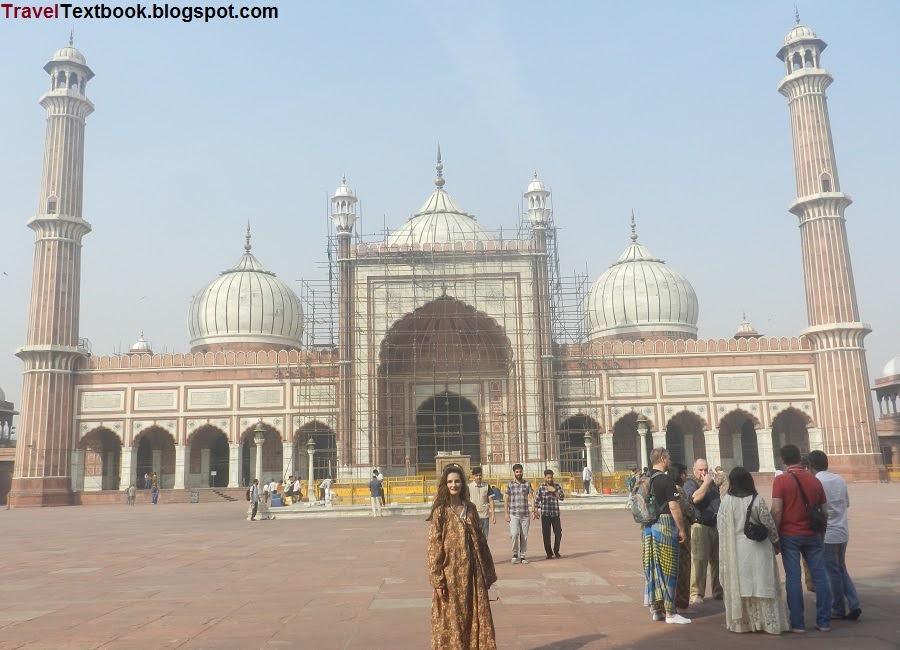
The Mughal Emperor Shah Jahan built the Jama Masjid on the highest point of Shahjahanabad between 1650 and 1656. It was built by about 6000 workers. The mosque was inaugurated on July 23, 1656. The original name of the mosque was 'Masjid-e-Jehan-Numa' given by Shah Jahan. Now 'Jami Masjid' has become common to people. The mosque was one of the last monuments built under Shah Jahan. After its completion, it served as the royal mosque of the emperors until the end of the Mughal period.
It is one of the largest mosque in India. The mosque has three entrances. Gate-1 is located in the South.
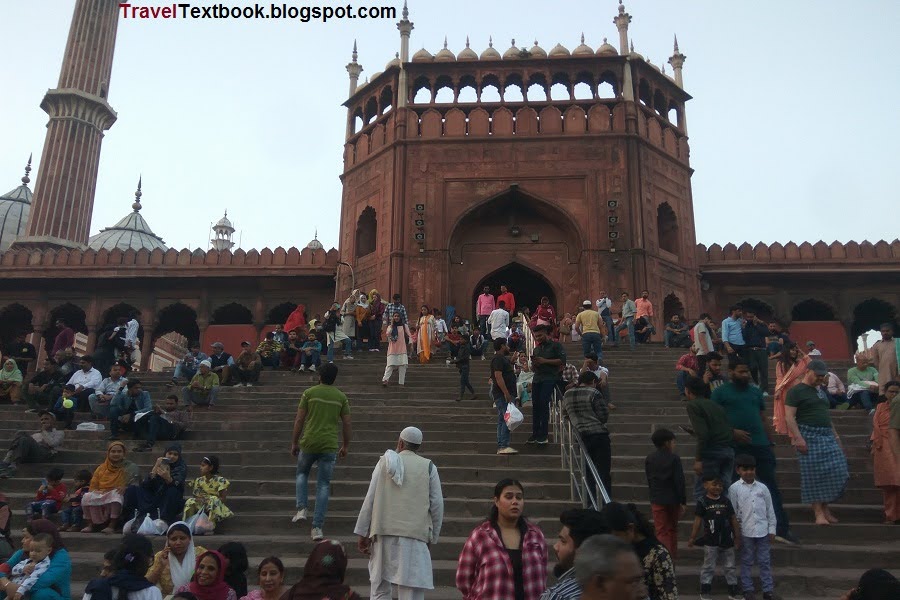
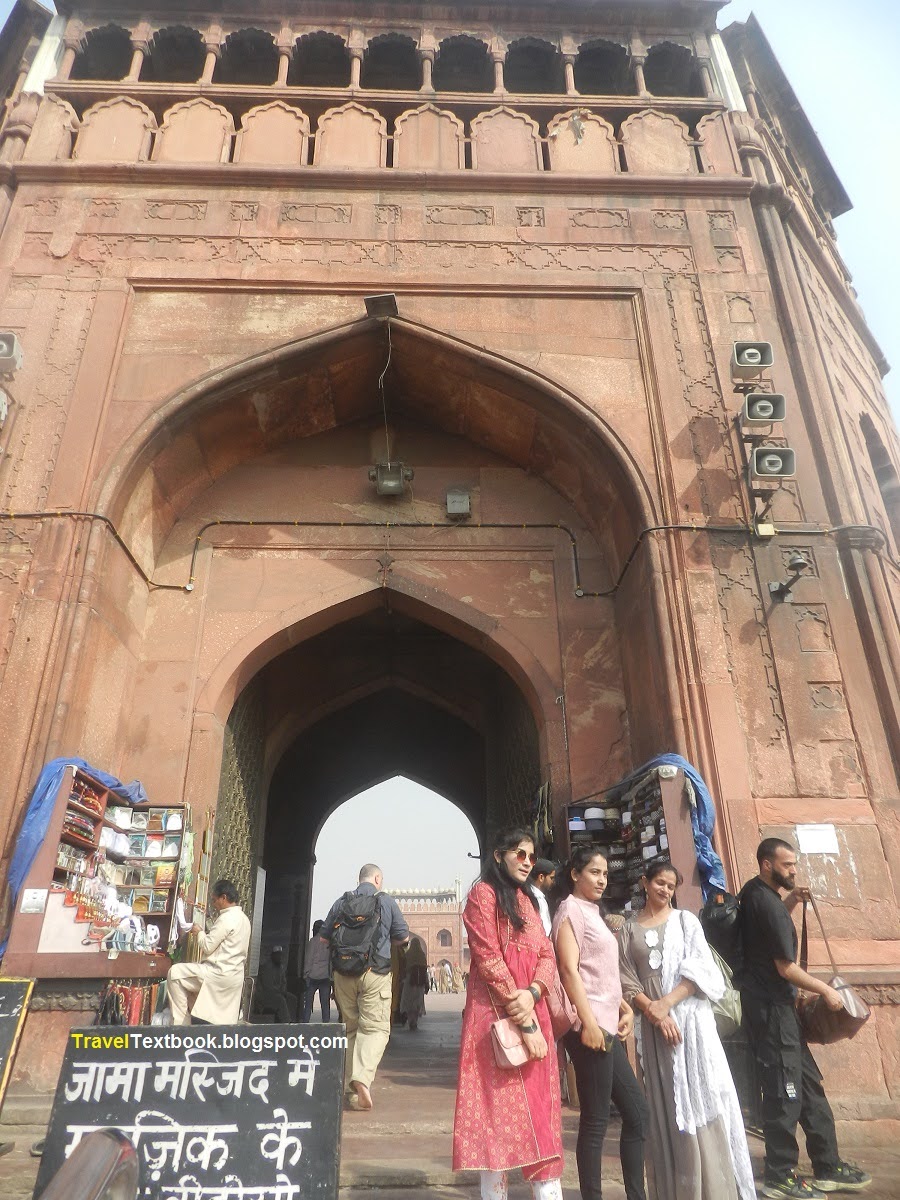
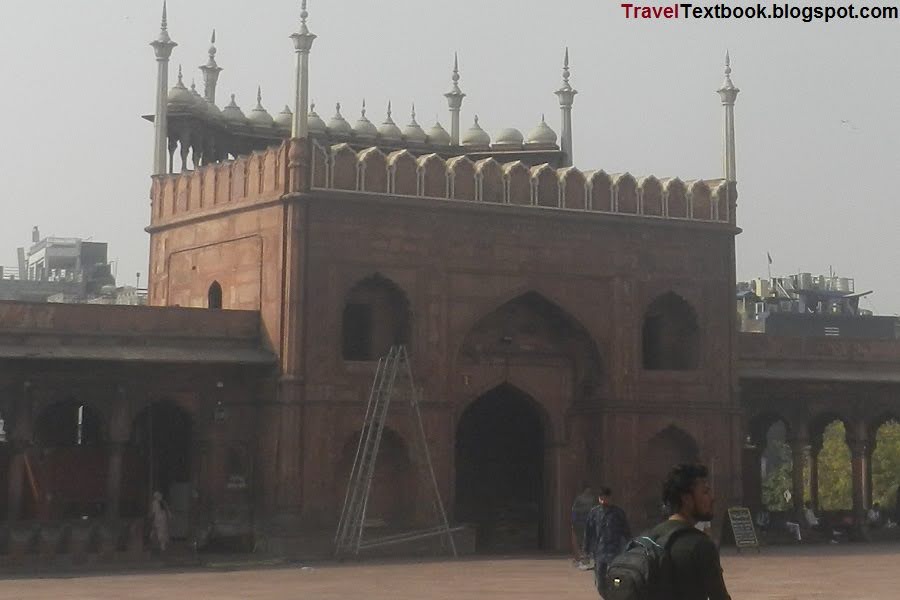
Gate-2 is located on the east side. It is larger than two others.
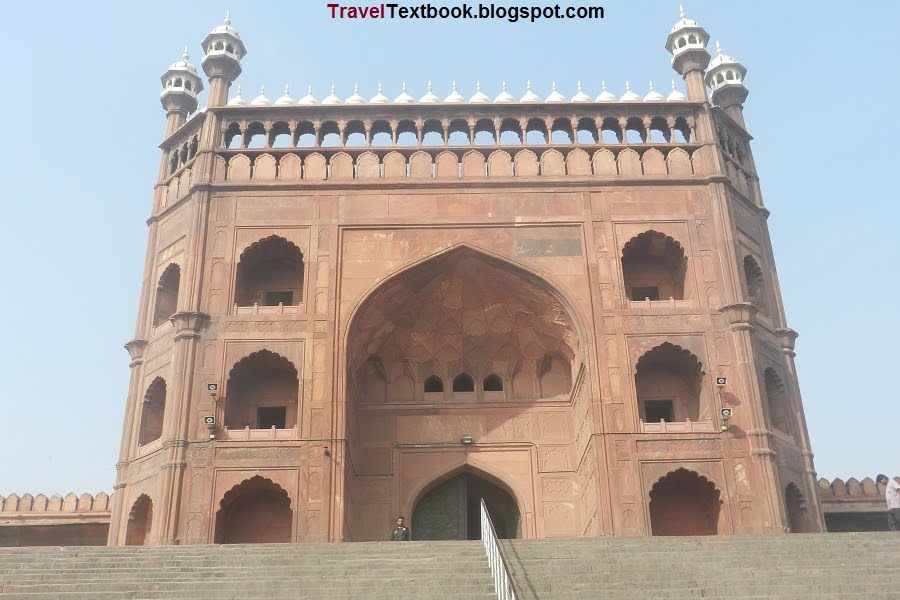

Gate-3 is located on the north side. This gate is open at 8 AM only for foreigners entry with a entry fee 300 Rupees (US$ 3.66). Everyone can enter after 10 AM.

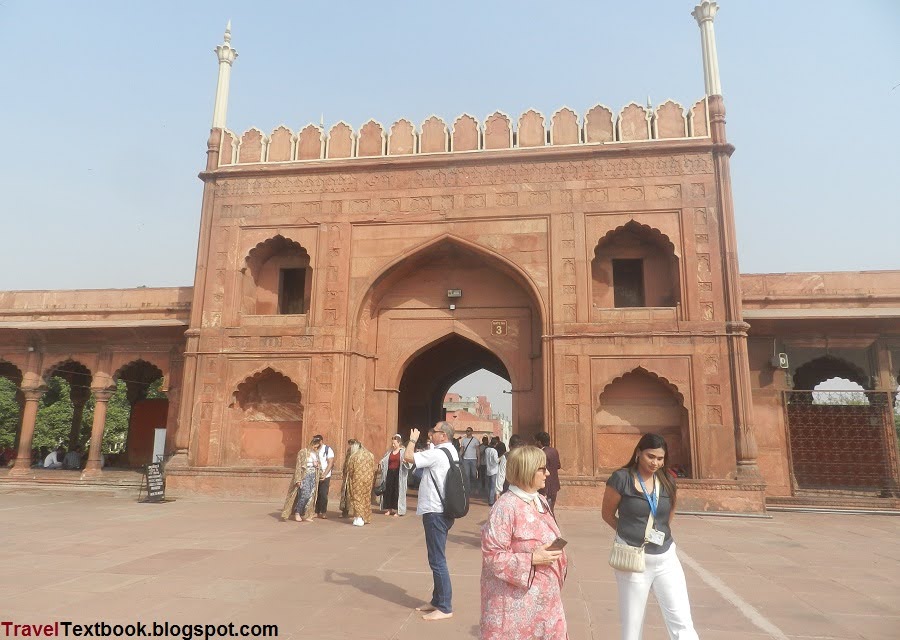
From the back side (northwest end road) view of the mosque.
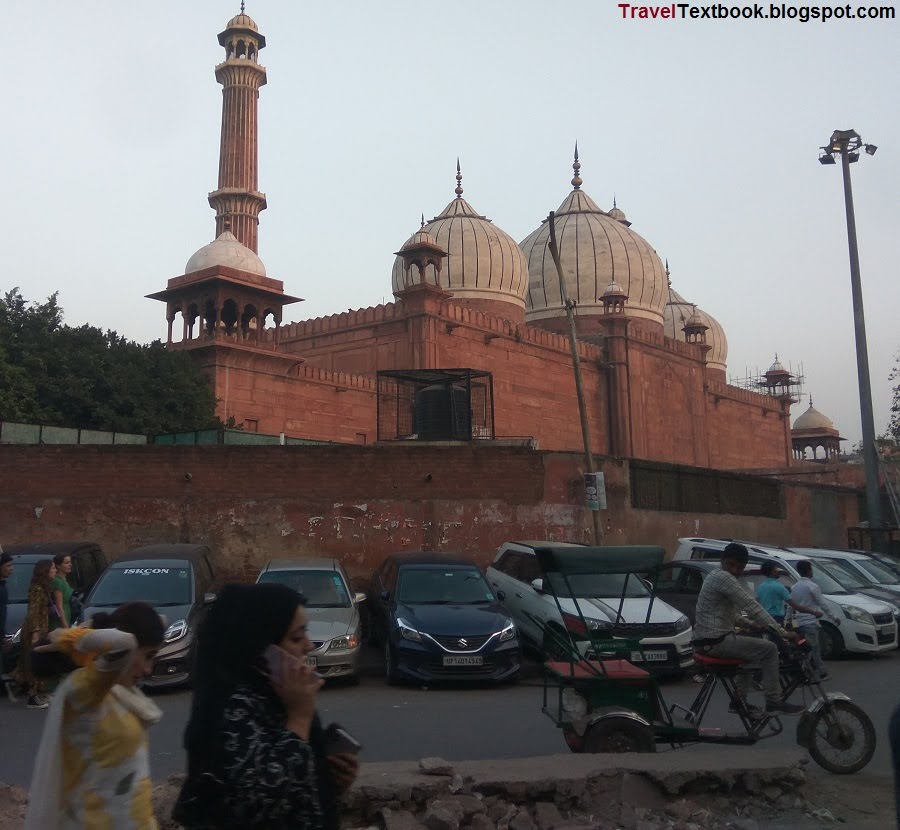
After entering the gate there is a large courtyard, which can accommodate 25,000 worshipers. In the center of the courtyard is a marble ablution tank. The main prayer hall is located at the western end. Two 40 meters high minarets on the both side of the main prayer hall. Each minaret consists of 130 steps.

There is a story that after building the mosque, Shah Jahan insisted that no one could pray in the mosque until Prophet Muhammad came to the mosque. He posted a huge guard at the gate so that no one could enter the mosque. Once he saw in a dream that the Prophet Muhammad was performing ablution in the north-west corner of the tank located in the middle of the mosque premises. Shah Jahan then came to the mosque with his army and told everyone about his dream and the place where Muhammad was performing ablution. Everyone entered the mosque, and saw that the place where Muhammad was performing ablution in the dream was wet with water. That means someone has performed ablution at that place, but the mosque was so guarded that no one could enter. Finally everyone realized that what Shah Jahan wanted had happened. Since then the place was cordoned off with an iron cage, so that no one could sit there, and the mosque was opened for prayers.
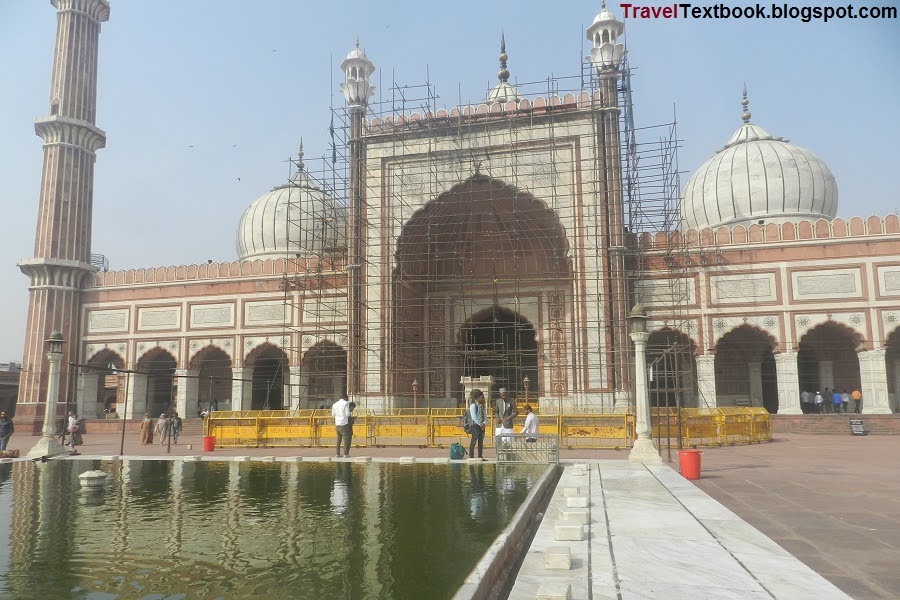
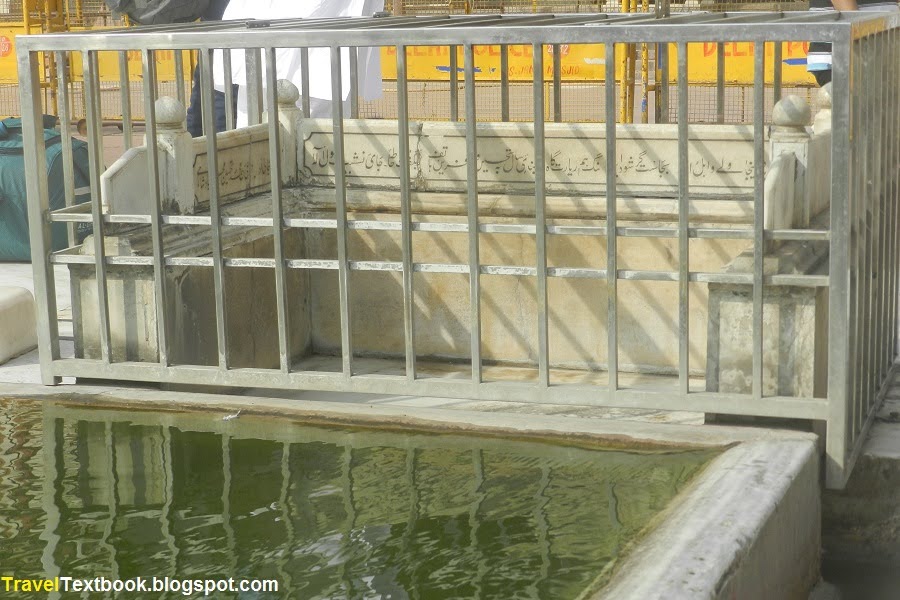
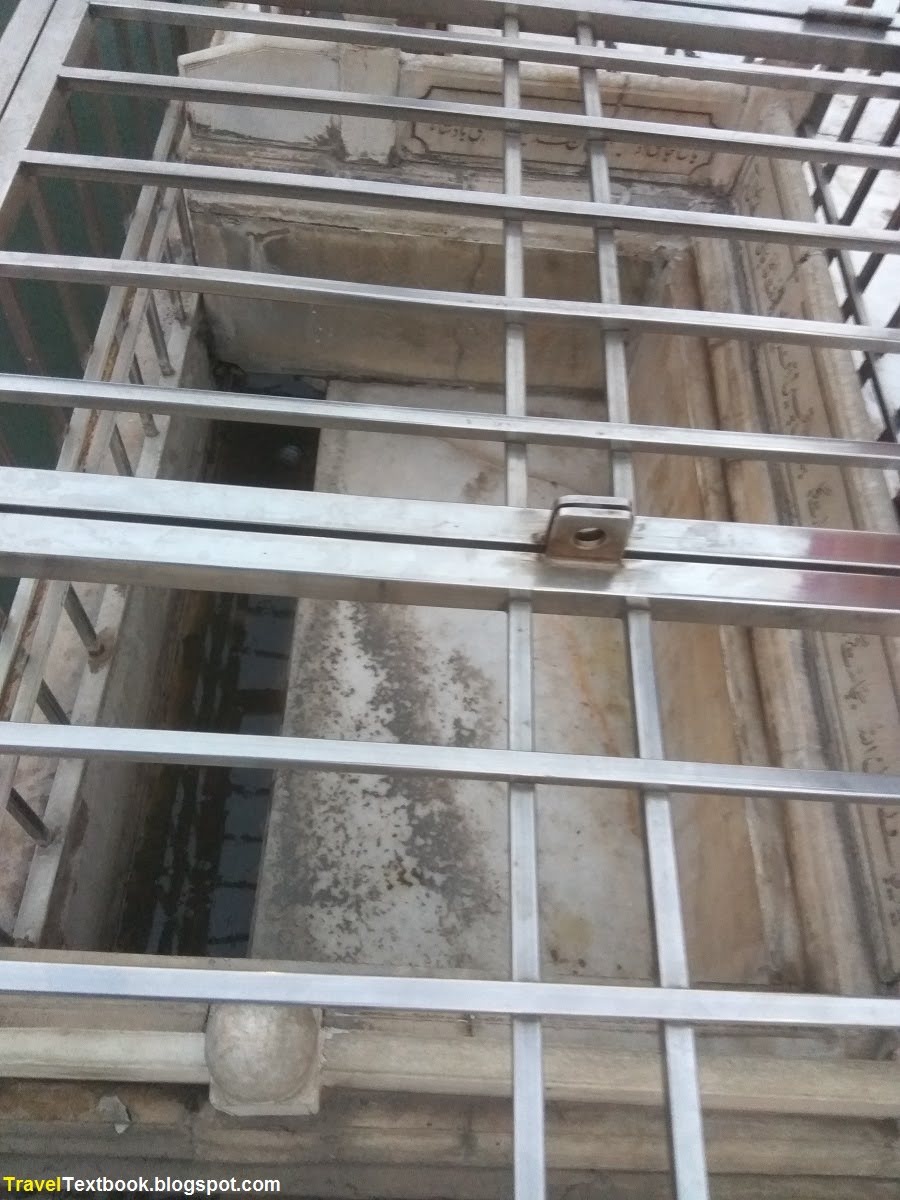

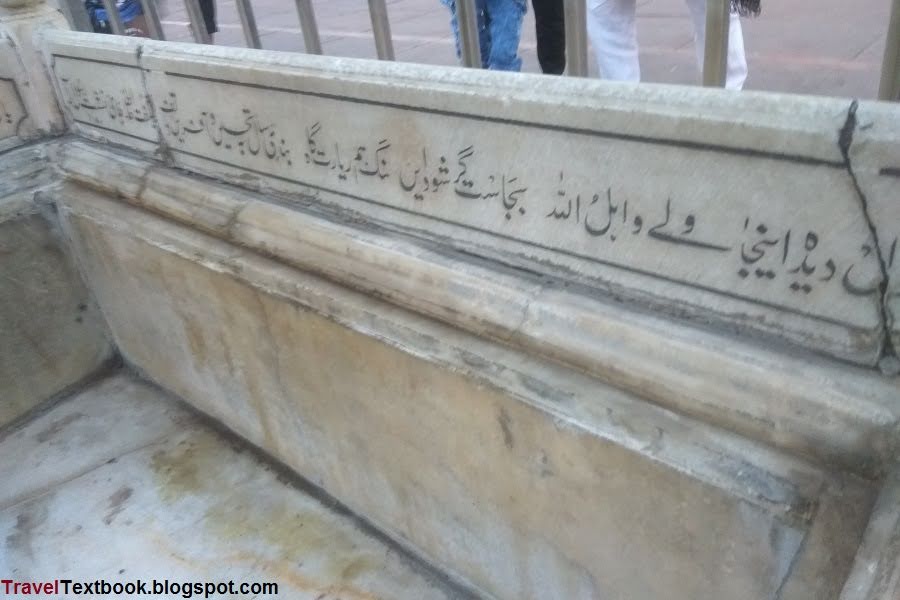
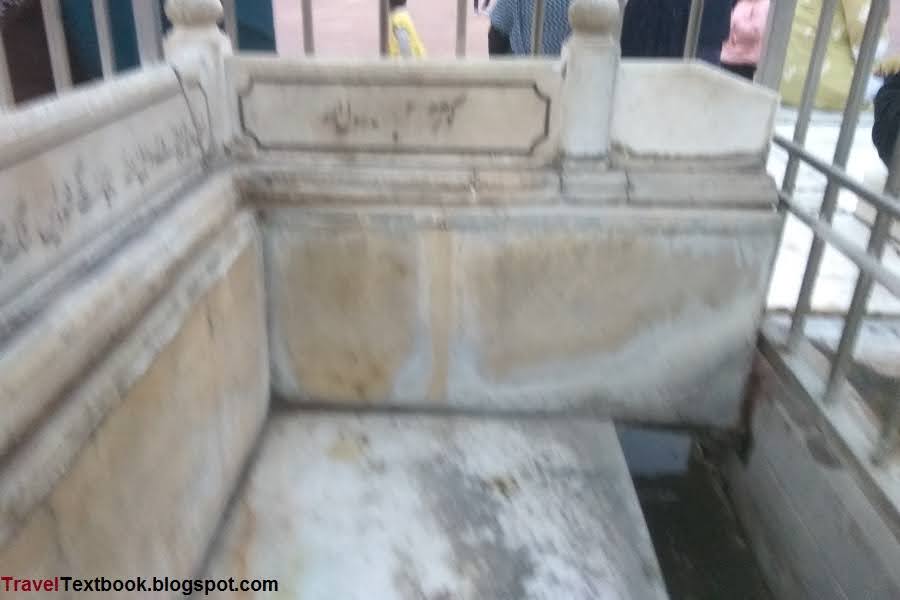
I entered the main prayer hall.
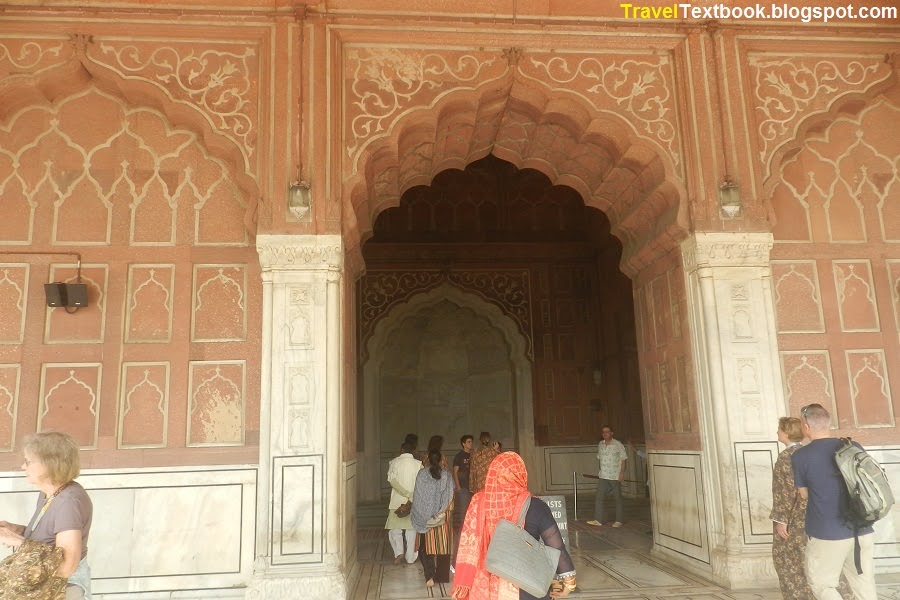
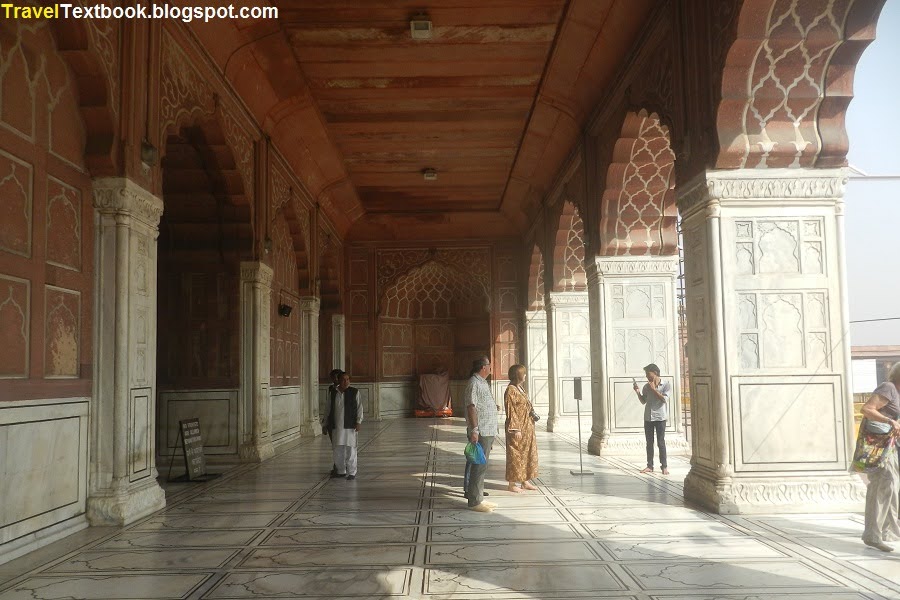
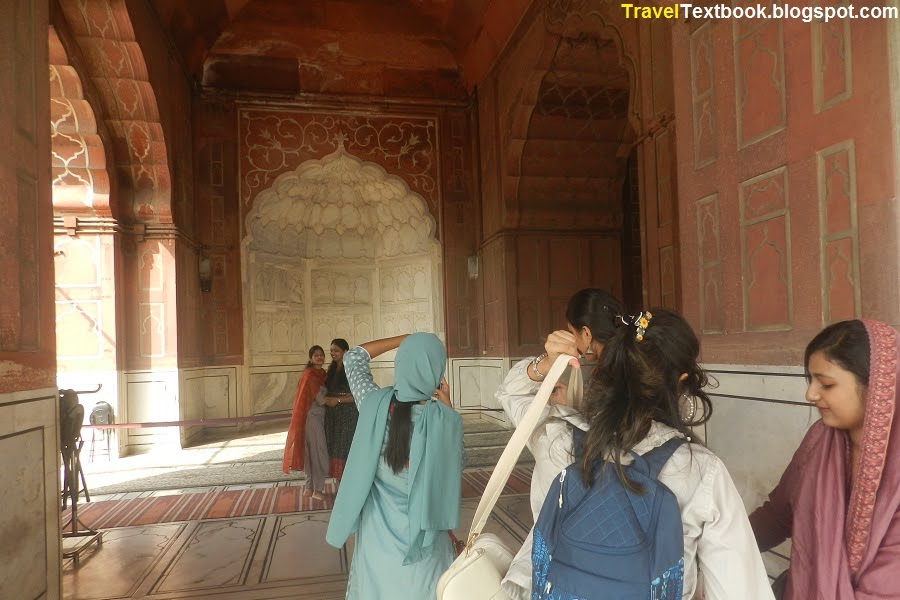


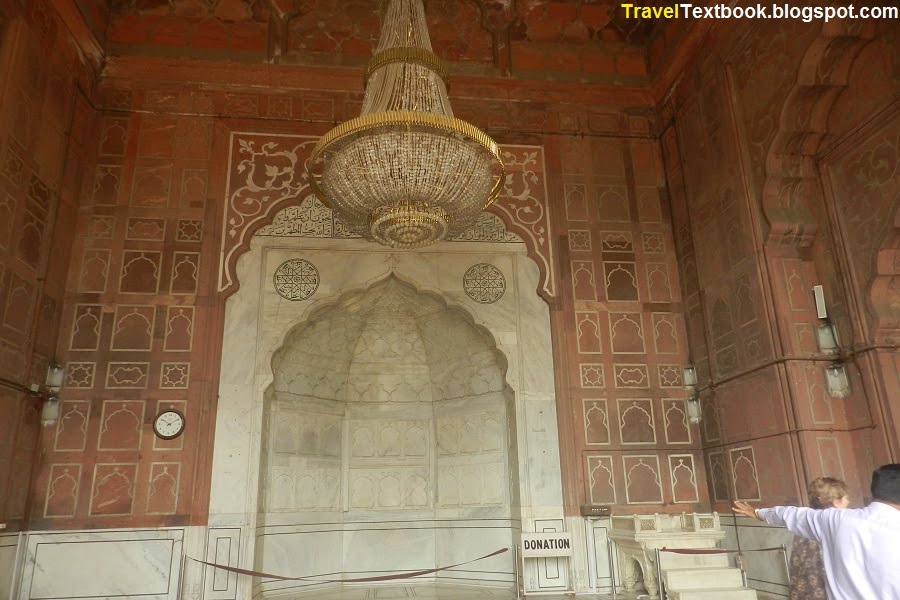
You can go up the South Minaret. For this you need to buy a ticket for 50 Rupees from the south end counter inside the premises. A few meters south of the South Minaret.

A very small entrance with tiny stairway, is located on the west side inside Gate-1. When you exit through Gate 1, it is located on the right, inside Gate-1 just before the exit.
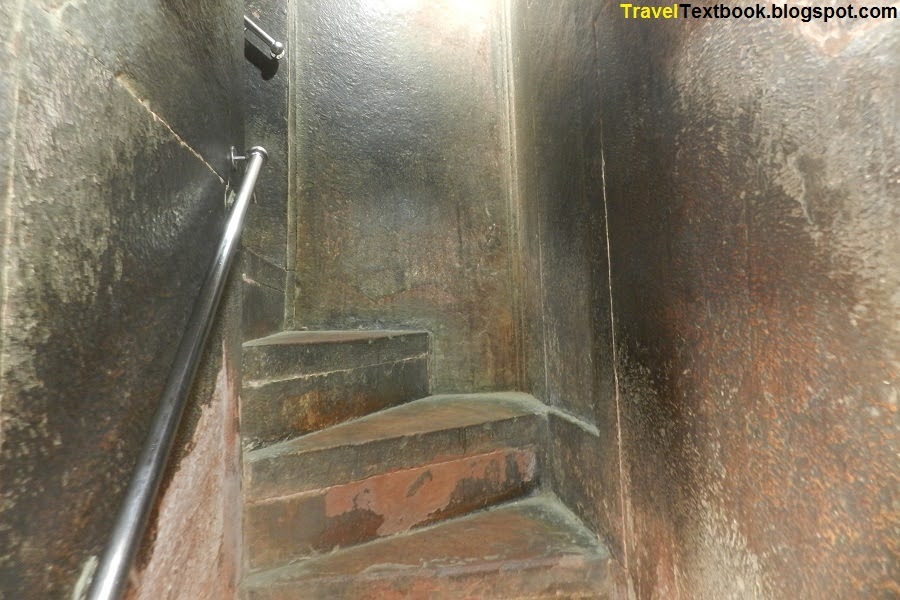


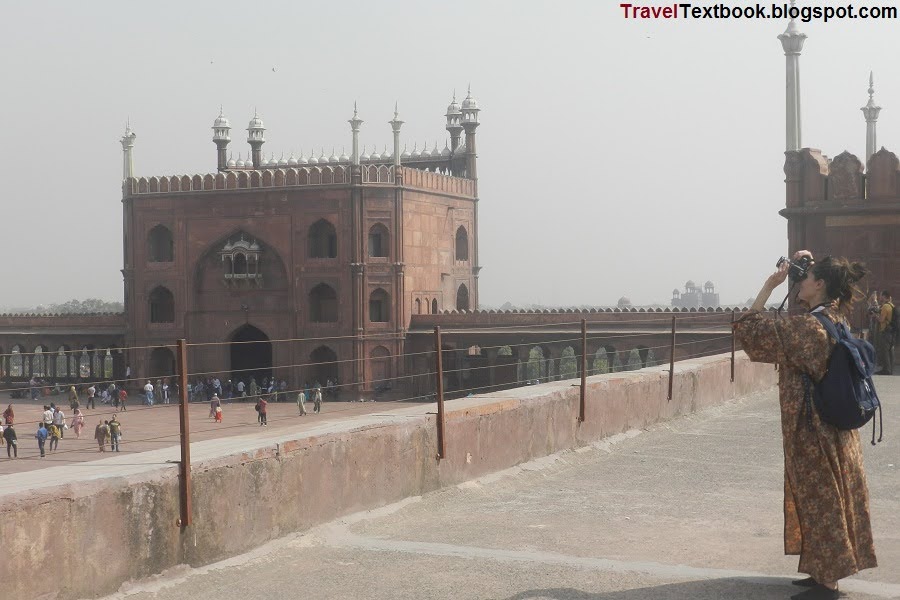

You have to go up a small staircase again to the entrance gate to the minaret. Here you have to keep the bag in front of the minaret gate. There an old man took 20 Rupees without a ticket to keep his bags and shoes.
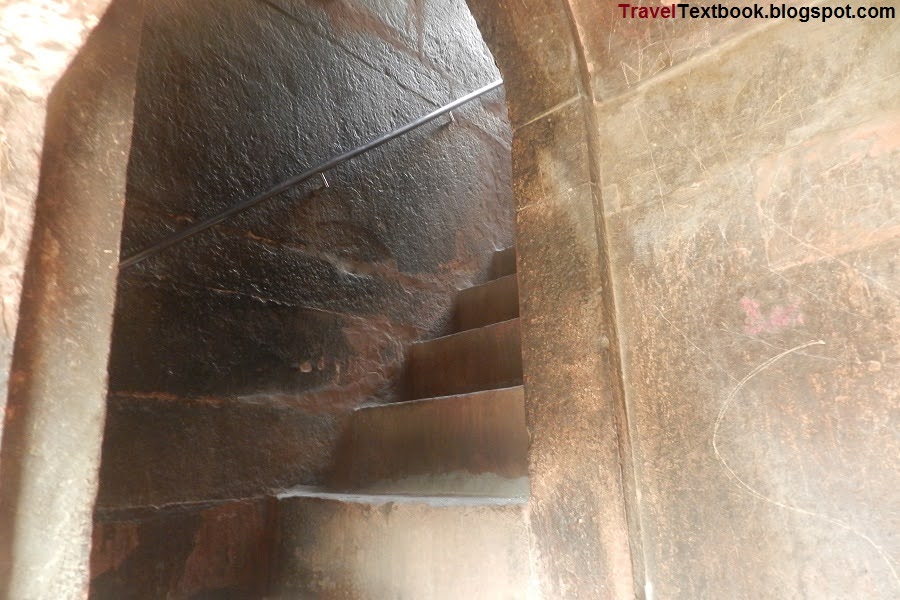
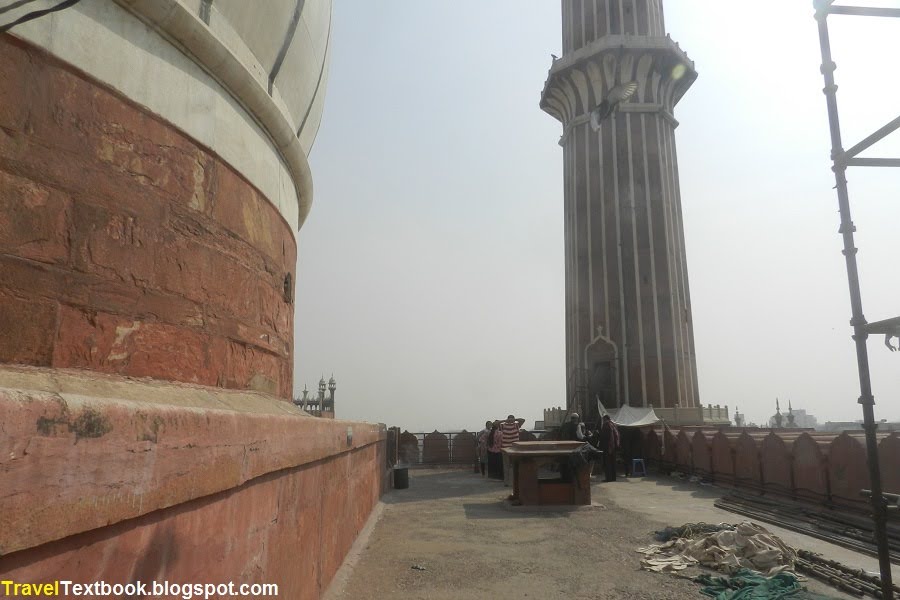


Now you have to go up the minaret stairs. The top space is also small.


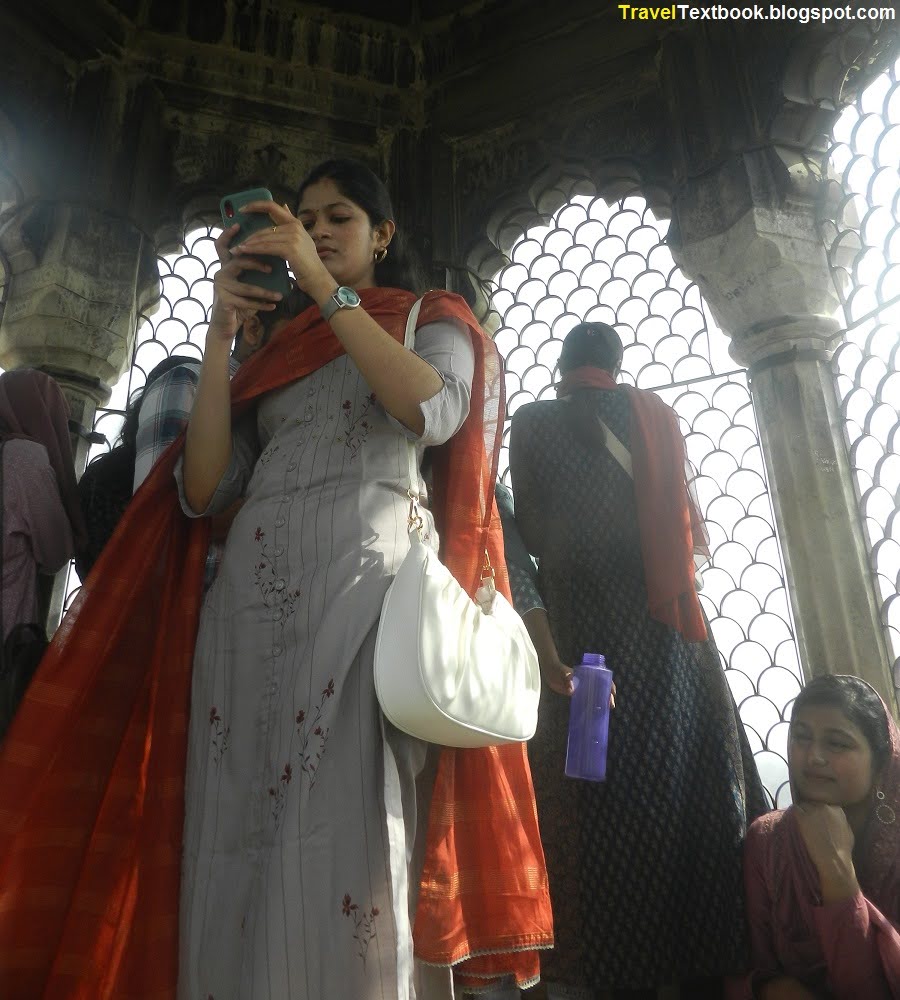
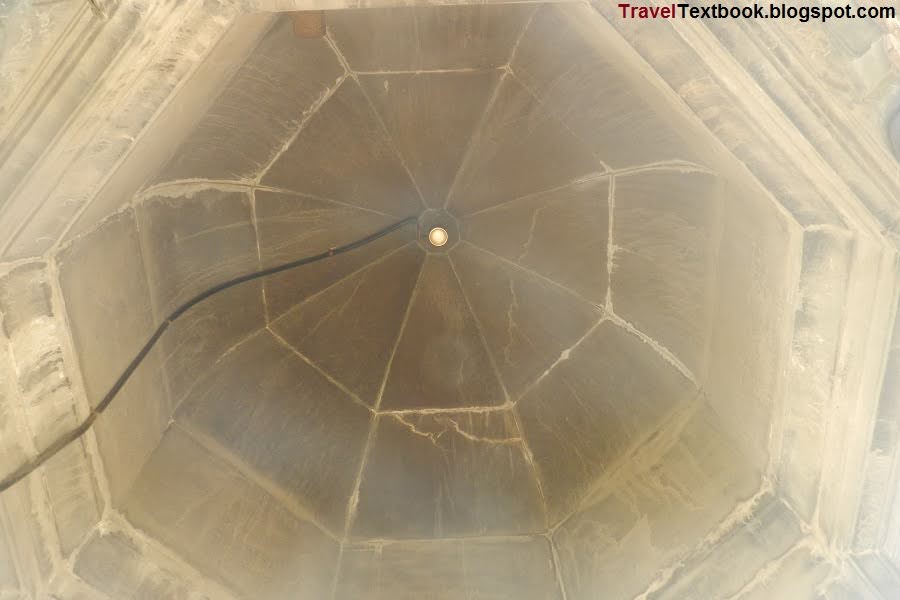
View from the top of the south minaret.

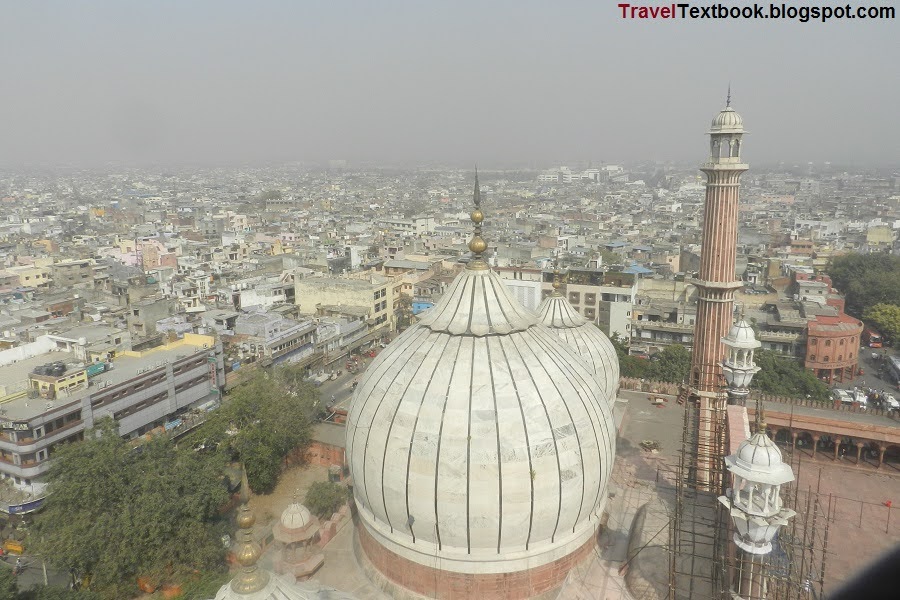
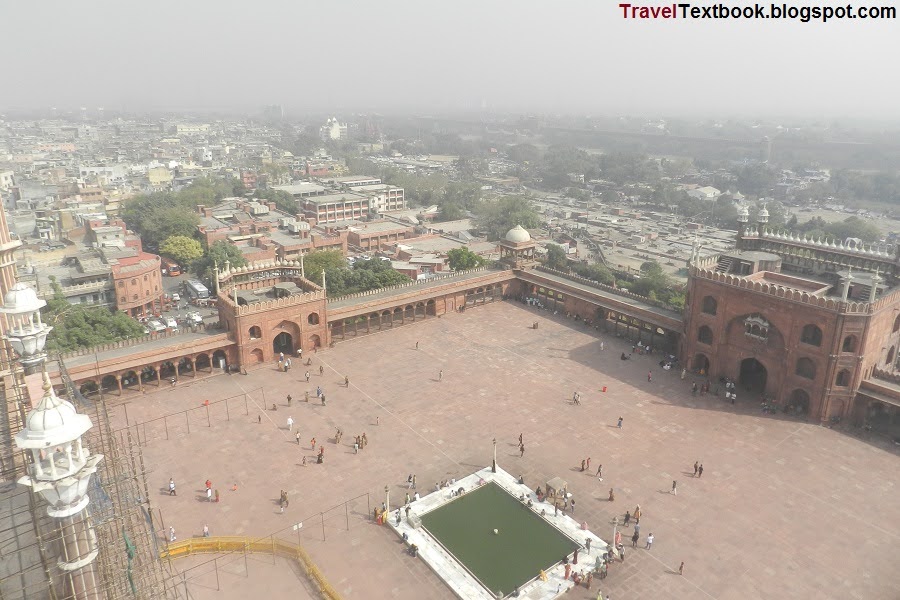
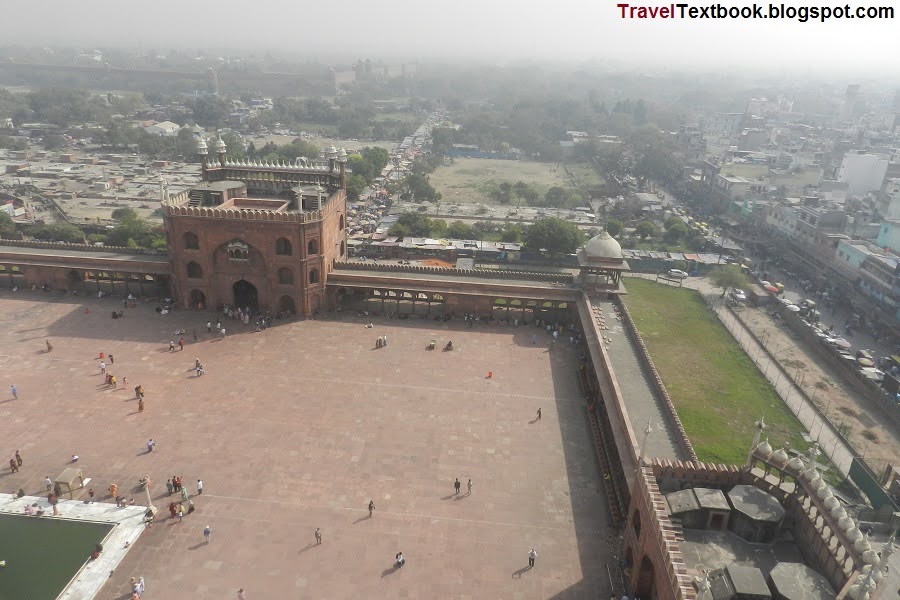
Evening view of the mosque.

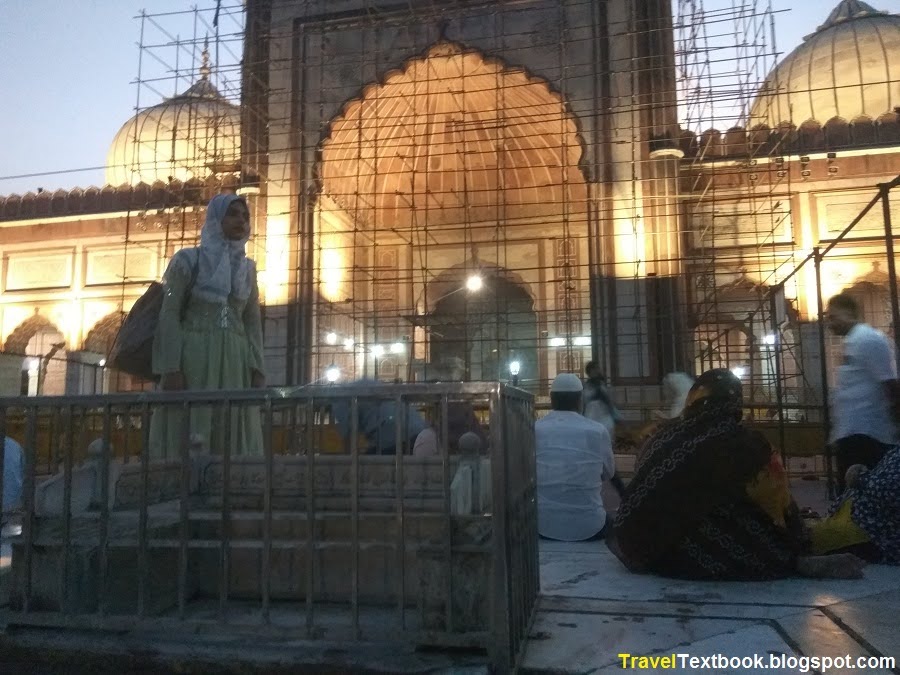
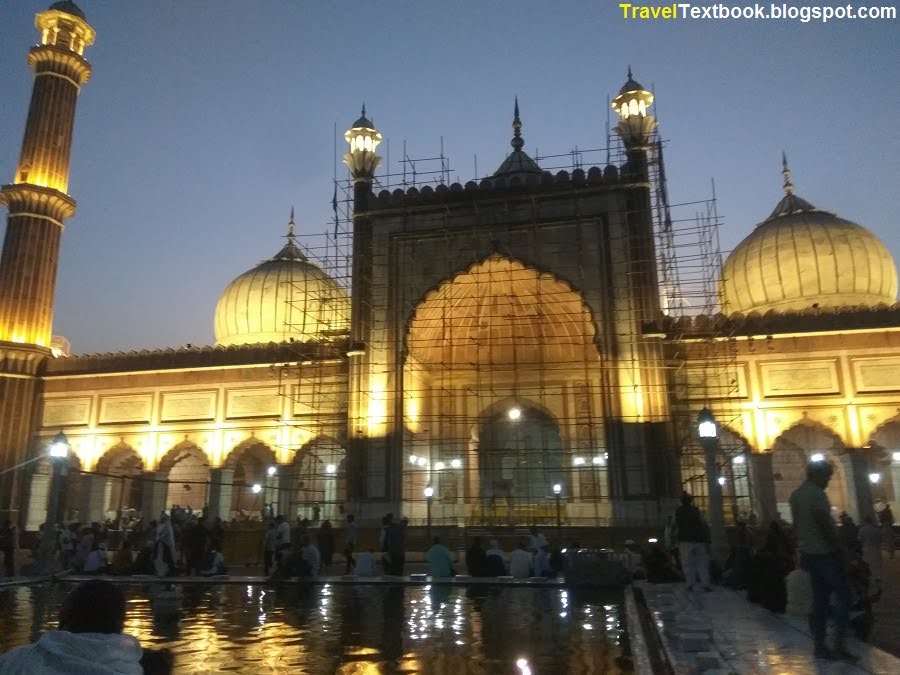
Visiting Time: 8 AM to 12 PM for foreigner and 10/11 AM to 12 PM for local, and 1:30 PM to 6:30 PM for all every day.
Entry Fee: 300 Rupees (US$ 3.66) for foreigner through Gate-3 in the morning. Free for local. 70 Rupees (US$ 0.84) for all to climb up the left side (south) Minar. On the top you need to keep bag. There is a charge 20 Rupees without ticket.
Photography: Photography and video allowed inside everywhere except professional video.
How to go: It is located about 400 meters from Jama Masjid Subway station (Violet Line) towards west.
Food near Jame Mosque:
Matia Mahal Road, opposite of gate-1, Jame Masjid is the best place for foodies, if you like spicy food.
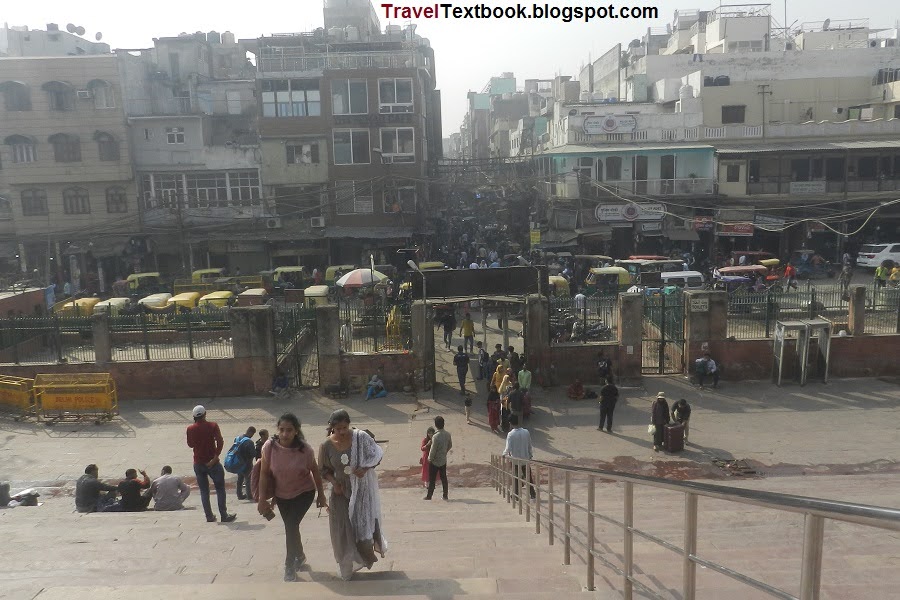
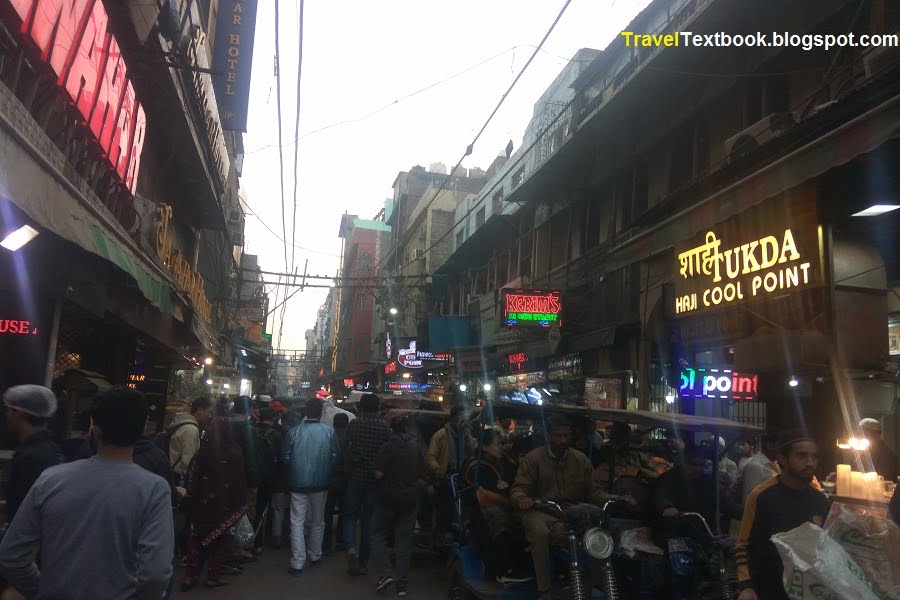

Mouth watering food such as -
* Chicken Jahangiri at Al Jawahar (No: 8), restaurant on the first left side of the road.
* Mutton Korma (310/590 Rupees), Chicken Tikka (360/660 Rupees), Kabab, Rumali Roti at Karim’s, just besides Al Jawahar.
* Butter Chicken at Aslam’s Chicken Corner (No: 636). A few meters inside the road from Al-Jawhar, the restaurant is on your right.
* These are expensive restaurants. If you want more budget but delicious food, then definitely visit Rehmatullah Hotel. Just a few shops after Al-Jawahar at the same side.
* What I did, I visited all the places today and ate here at the end of the day for dinner.
Sunehri Masjid, Red Fort
Mosque
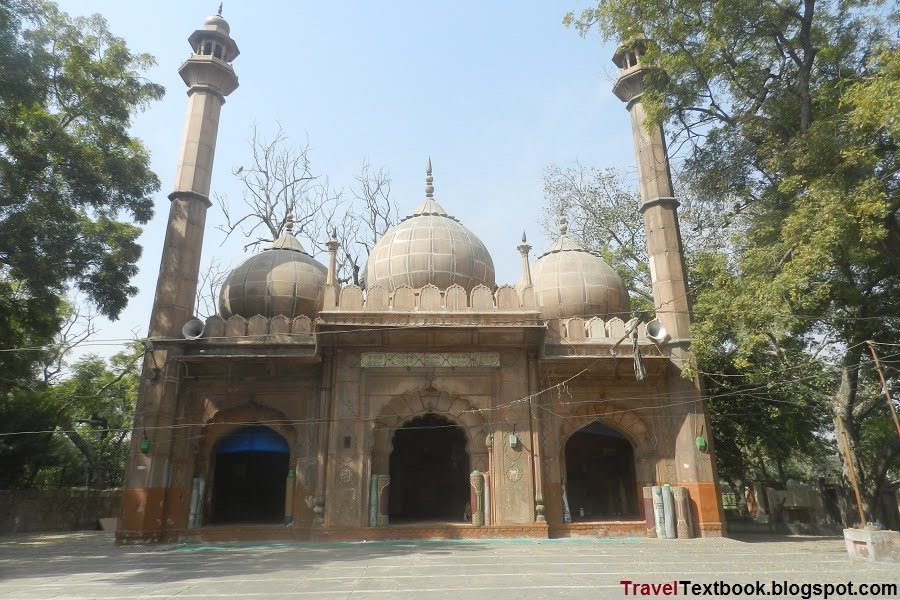
The mosque was built between 1747 and 1751 on the orders of Qudsiya Begum (pronunciation: Kursia), mother of Emperor Ahmad Shah Bahadur, for Nawab Bahadur Javed Khan, a nobleman during the reign of Emperor Ahmad Shah Bahadur. Javed Khan was the caretaker of the mosque and was very favorable to the Begum. He was later killed.
Nawab Ahmad Bakhsh Khan, father of the Nawab of Ferozepur (reigned 1351–1388), repaired the mosque for the benefit of the surrounding people. Shortly after its renovation, he was attacked by an angry elephant while out with his son. His horse was killed and his vehicle destroyed in the attack. The Nawab and his son escaped death only by taking shelter inside this mosque.
Visiting Time: Sunrise to Sunset.
Entry Fee: Free.
Photography: Allowed.
How to go: The mosque is about 600 meters east from Jame Masjid Gate-2. Walked straight east from Gate-2. The road ends at Netaji Subhash Marg, where a left turns towards Red Ford. But I crossed the road, turned right (south) and walked. Then I first turned left (East) and walked. Then again I turned left (north) and walked. The mosque is on my left. This road straight goes towards Red Fort "Delhi Gate". From Jama Masjid metro station (violet line), the mosque is about 550 meters towards northeast.
Chandni Chowk
Market Area
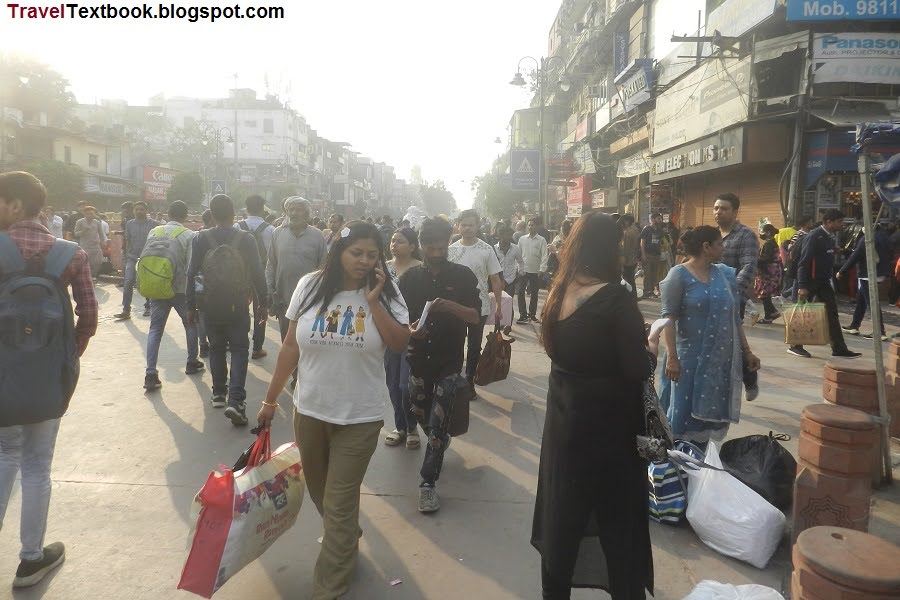
Chandni Chowk is one of the oldest and busiest markets. Mughal Emperor of India Shah Jahan (1592–1665) built this market, which was designed by his daughter Jahanara. The road goes from the opposite of the Red Ford till Fatehpuri mosque is called "Chandni Chowk Street". About 1.3 km east-west street.
Shops: There is electronics market at the northeast of Chandni Chowk street. Then you will get Light market on the west of electric market. Then dress market, specially woman's wear. Spice Market starts from Fatehpuri Mosque. Then you will get Chocolate, Pickles and food shops.
How to go: It is located west of Red Ford, and just west of Lal Quila Metro Station (Violet Line) exit through gate-1.
Sri Digambar Jain Lal Mandir
Jain Temple
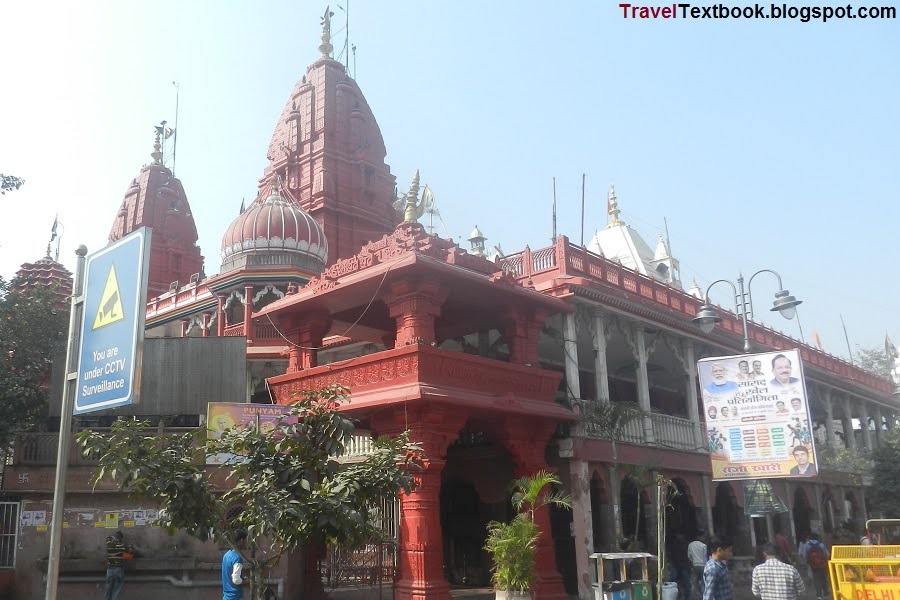
The Mughal Emperor Shah Jahan (1628–1658) invited several Agrawal Jain merchants to settle in the city and granted them some land. The Jain first temple here was built at this place in 1656.
According to Balabhadra Jain, Shah Jahan's successor Aurangzeb once ordered the banning of all musical instruments in temples. Miraculously, the sound of drums could be heard from the temple despite the visits of Mughal officers. Aurangzeb himself visited the temple to witness the miracle and eventually lifted the ban. Balabhadra Jain states that one of the idols in the temple dates back to 1491, and was originally founded by Bhattaraka Jinachandra.
The present temple buildings were built after the fall of the Mughal Empire and from 1878 onward.
There are several Jain temples in the area but the main one is of Lord Mahavira, the 24th and last Tirthankara of the present era. Born as a prince in Bihar in 599 BC, he leaved all worldly comforts and went in search of salvation. He soon gained enlightenment, and spent the rest of his life preaching to people all over the country. Although some believe that he was the founder of Jainism but in reality he was a reformer of an existing religion who reformulated and presented the principles of the religion in a form suitable for the age.
I entered the gate and took off my shoes and put them in the corner.
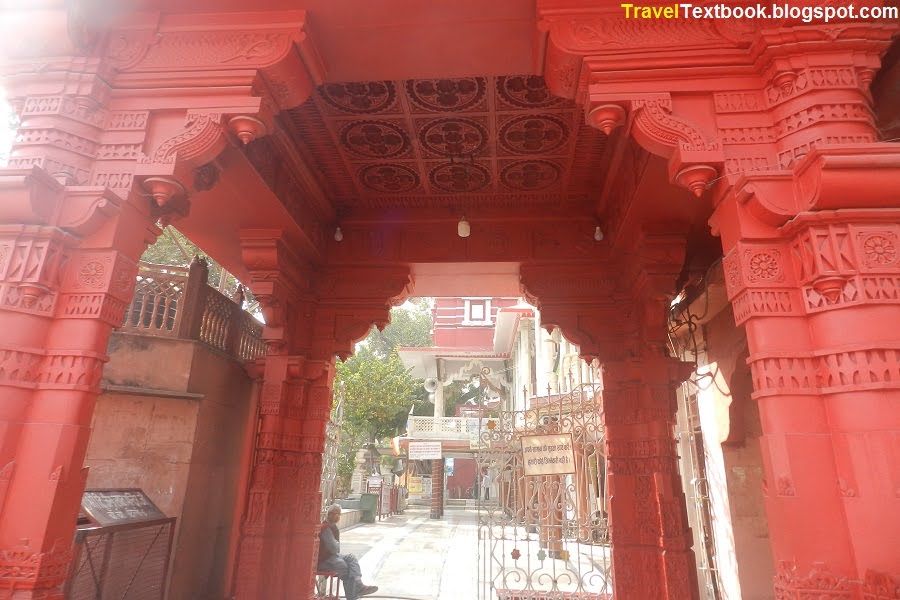
The complex also has a bookstore where a wide range of books on Jainism are available. Then I took photos of the structures inside the premises.
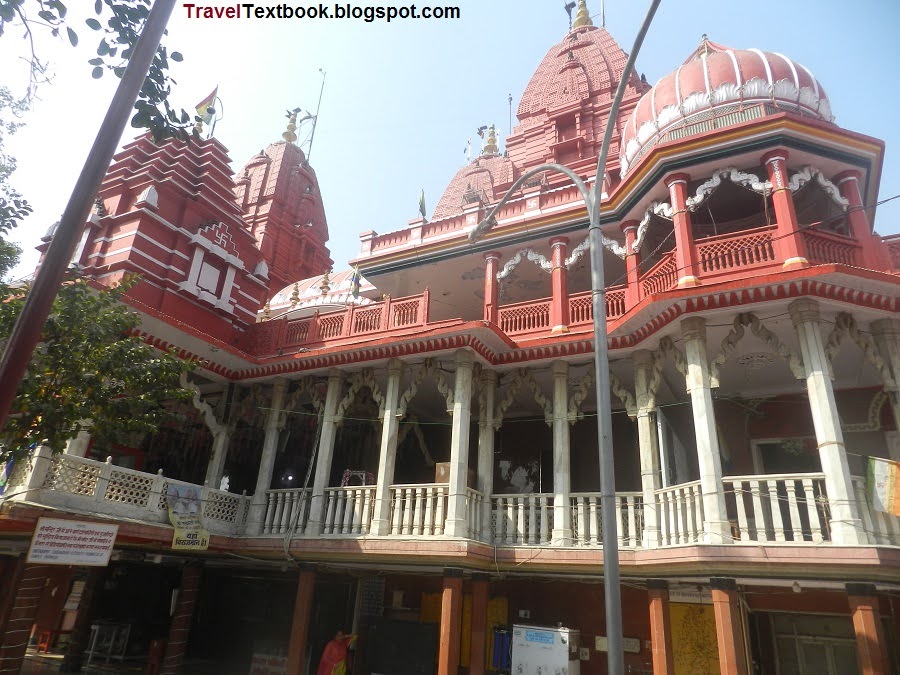
Then I went to the temple. It's on the second floor. Bags should be kept on the ground floor. Photography is not allowed inside the temple but you can take your camera. There are statues of Rishabhanatha, the first Tirthankara, and Lord Parshvanath, the immediate predecessor of Lord Mahavira.
There is a famous Bird Hospital left side of the temple inside the premises. The hospital was started in 1930, and the present building was constructed in 1957. The Birds Hospital is the only facility of its kind in the world, treating around 15,000 birds annually.
Visiting Time: Holi to Diwali (Summer times) - 5:30 AM to 11:30 AM and 6 PM to 9:30 PM. Diwali to Holi (Winter times) - 6 AM to 12 PM and 5:30 PM to 9 PM.
Entry Fee: Free.
Photography: Allowed except inside the temple on 2nd floor.
How to go: It is located just opposite the East Road from the main gate of the Red Fort. Southeast corner of Chandni Chowk Road. When I came out of the gate-1 of the metro station, I saw the temple in front of me.
Gauri Shankar Temple
Hindu Temple
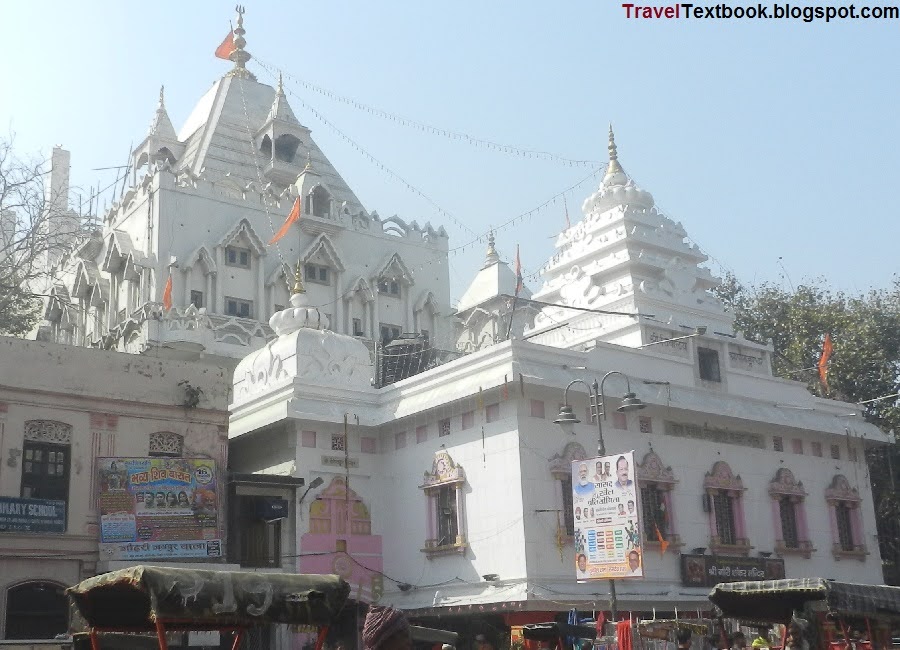
Gauri Shankar Temple is dedicated to Lord Shiva. According to Hinduism, the love story of Parvati and Lord Shiva is called Gauri-Shankar.
The temple was built by Apa Ganga Dhar, a Maratha soldier. It is said that he was once seriously wounded in battle and had no chance of survival. So, he prayed to Lord Shiva for his life and promised to build a beautiful temple if alive. He survived and built the temple in 1761.
Inside the temple, there is an 800-year-old brown Lingam (phallus stone) surrounded by snakes made of silver. Above the Lingham is a silver water pot from which water drops continuously. Depicts of Lord Shiva and his consort Parvati and their two sons Ganesh and Kartika are present. The idols of Shiva and Parvati, adorned with original gold ornaments, are located under a silver canopy just behind the Lingam.
Visiting Time: 5 AM to 10 AM and 5 pm to 10 PM. The best time to visit the temple is during the festival of Shiv Raatri. One can visit the temple especially on Mondays, which is day of Lord Shiva. The temple is open throughout the year and welcomes visitors of all castes and religions.
Aarti Time: 6 AM and 7 PM.
How to go: The temple is located just on the western side of the Jain Lal Mandir.
* Eat Japani Samosa at Manohar Dhaba Japani Samose Wale.
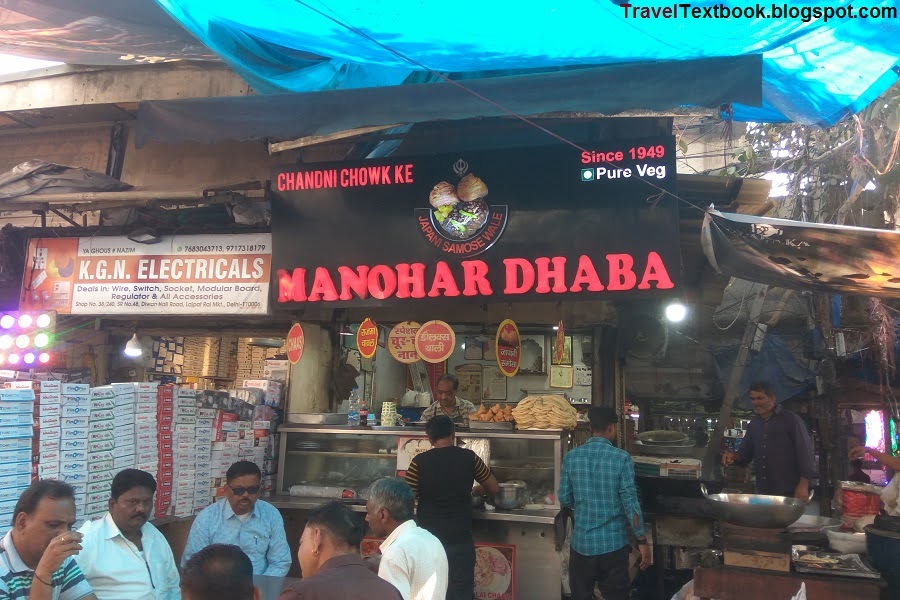
Enter right side street, opposite of Gauri Shankar Temple. Walk few meters towards north. It is serving since 1949. Open from 9 AM to 7:30 PM every day. Single Japani Samosa 25 rupees, and plate 40 rupees (2 Samosa with Chhole). The shop is located opposite of Moti Cinema Movie theater, which was the third oldest single screen cinema in Delhi after Regal and Plaza Cinemas in Connaught Place. This cinema hall has several golden memories as many actors and actresses visited here including Raj Kapoor, Shah Rukh Khan, Juhi Chawla and Ranbir Kapoor.
Bhagirath Palace
Historical Landmark

Begum Samru's Palace at Chandni Chowk, now called Bhagirath Palace, was built in a garden gifted by Akbar Shah (reigned 1806 - 1837) to Begum Samru (Farzana Zeb un-Nisa) (1753 - 27 January 1836). The building still stands, and is currently owned by the State Bank of India, Chandni Chowk branch.
How to go: It is located right side (north) of Chandni Chowk street. About 150 meters from Sri Digambar Jain Lal Mandir towards northwest.
Central Baptist Church
Church

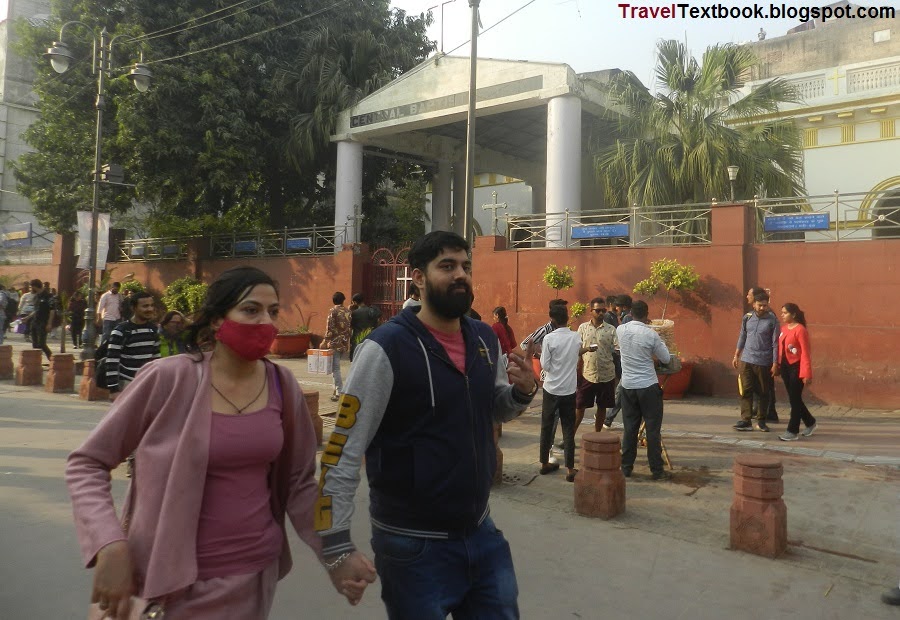
The Baptist Missionary Society (BMS), London, purchased the land, where the church was established in 1814.
The church is well maintained with its original motifs and carvings. The roof of the church has been repaired with stone and iron beams. On the walls of the church are commemorative tablets commemorating the faithful who devoted their entire lives to the service of the church.
How to go: It is located west after the McDoland's restaurant building from Bhagirath Palace.
Eat Jalebi at Old Famous Jalebi Wala.
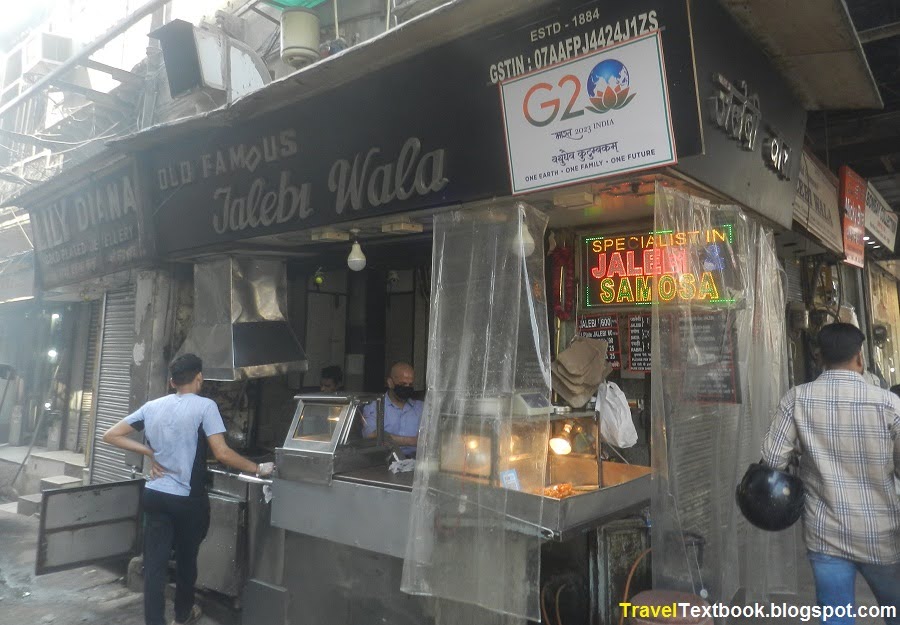
It was established in 1884. Jalebi 600 Rupees per kilo. You can purchase minimum 100 gram at 60 Rupees. I crossed the road from Baptist church and walked about 30 meters towards west. The store is located entry point of Dariba Kalan Road. Above the road entrance there is a sign board with the name of the road.
Khazanchi Haveli
Ruined Mansion
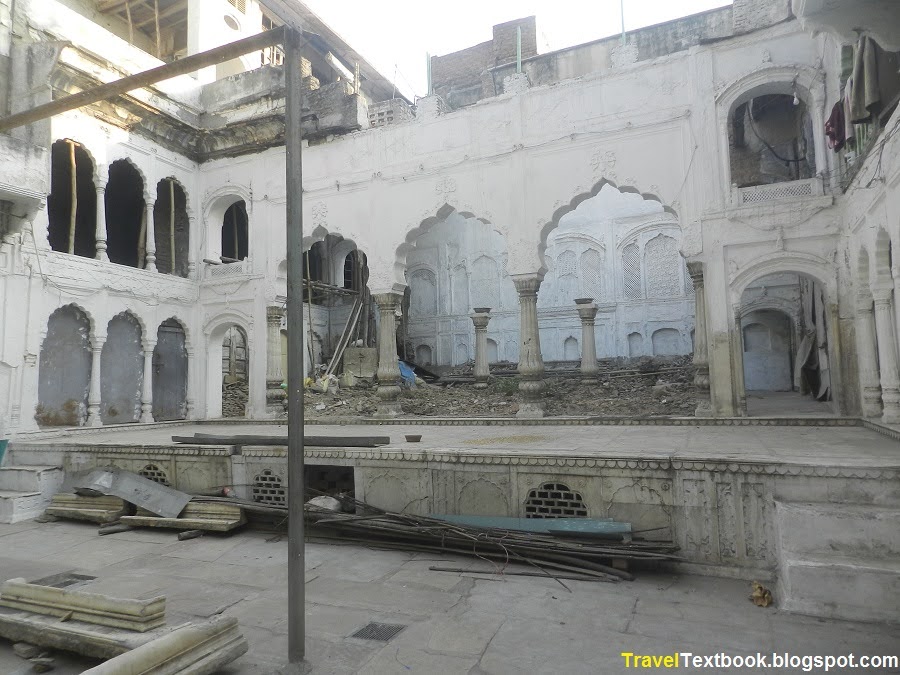
Khazanchis were the accountants of Shah Jahan (reigned January 1628 to July 1658). A road is named after them "Gali Khajanchi", a long tunnel connects the haveli and the Red Fort, so that money can be transferred safely. Now the haveli is ruined.
How to go: 4 Pictures below shoe how to reach the mension. Entrance of Dariba road, Jelebi wala shop is located right hand side.
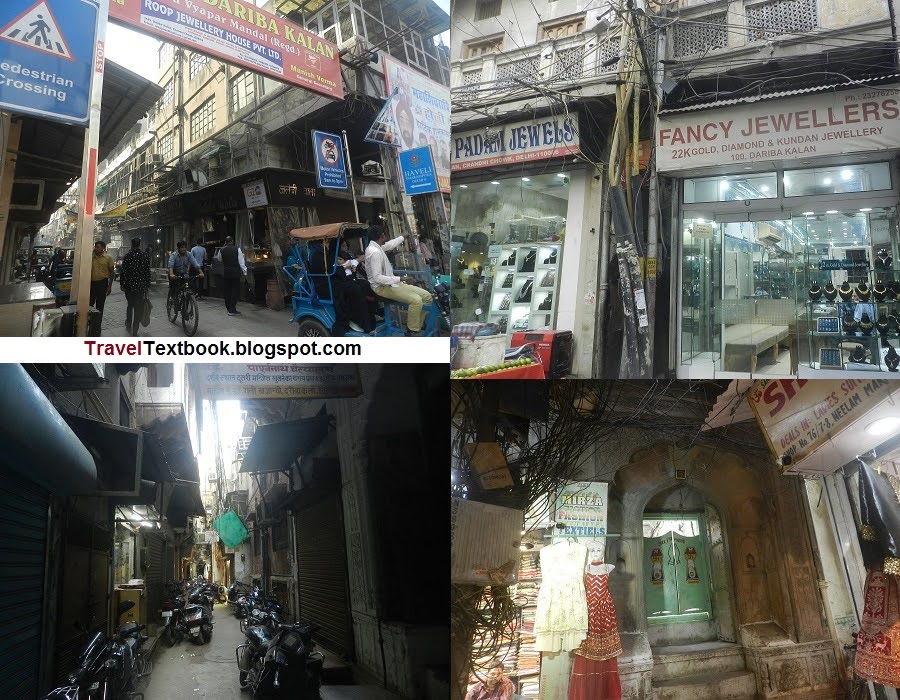
Enter the Dariba road and walk towards south, just turn the first left narrow street showed in the picture. Go to the end of the street (east), where a walkway goes to left and a green gate on the right. Enter the gate and you will reach the ruined haveli.
Gurdwara Sis Ganj Sahib
Gurdwara
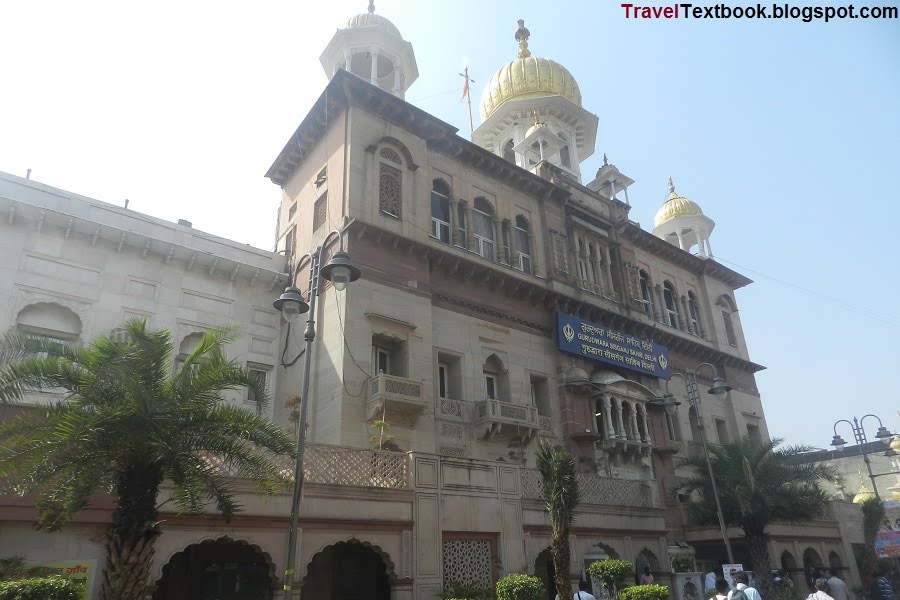
It is one of the Gurdwara of Sikh religion.
Guru Teg Bahadur:
Guru Teg Bahadur was the ninth Sikh Guru in Sikhism. He was beheaded on 11 November 1675 on the orders of the Mughal emperor Aurangzeb where Gurdwara Sis Ganj at Chandni Chowk now stands. Before the dead body could be quartered and brought to light, his head was stolen during dark to Sri Anandpur Shahib by Jeevan Singh and Bhai Jaita Ji. His body was taken by one of his disciples, Lakhi Shah Vanjjara, to his house who then set his house on fire to cremate the guru's body; Today Gurdwara Rakab Ganj Sahib stands at that place.General Baghel Singh built seven small structures gurdwaras from April to November 1783. They are -
1. Gurdwara Nanak Piao 2. Gurdwara Bangla Sahib 3. Gurdwara Damdama Shahib 4. Gurdwara Majnu Ka Tilla 5. Gurdwara Mata Sundri 6. Gurdwara Rakab Ganj 7. Gurdwara Sis Ganj.
Sis Ganj was one of the temples at this sacred place. The present structure was added in 1930. The gold crown of the dome was added in 1931.
Entry Fee: Free.
Photography: Photography is allowed inside the premises but prohibited inside the shrine.
How to go: It is located about 70 meters from entrance of Dariba street or from the Old Famous Jalebi Wala shop towards west.
Bhai Mati Das Museum
Museum

Bhai Mati Das was a martyr of early Sikh history. In 1675 he was publicly executed at the Kotwali (police station) in Chandni Chowk area on the orders of Emperor Aurangzeb. Bhai Moti Das was killed by being tied between two pillars and cut in two.
Visiting Time: 7 AM to 7 PM. Cover your head and remove your shoes before go inside the museum.
Entry Fee: Free.
How to go: It is located opposite (north) of Gurdwara Sis Ganj Shahib.
You can taste sweets at Annapurna Bhandar.

The shop was established in 1929 by Late Mr.Purna Chander Modak is popular for Bengali sweets. It is located west of Bhai Mati Das Museum.
Shahi Sunheri Masjid
Mosque
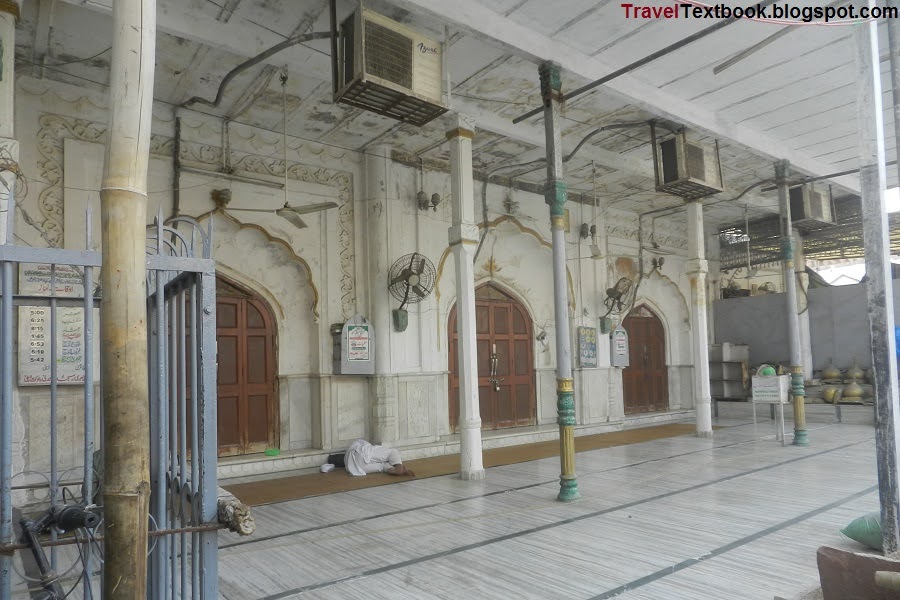
The mosque was built in 1721 by the Mughal noble Raushan-u-daulah during the reign of Muhammad Shah. It was from here that Persian King Nadir Shah witnessed the massacre of the citizens of Delhi on March 11, 1737 after defeating the Mughal ruler Muhammad Shah.
How to go: It is located just opposite (south) of Annapurna Bhandar. West of Gurdwara Sis Ganj Sahib.
Mahavir Bhawan
Worship Place
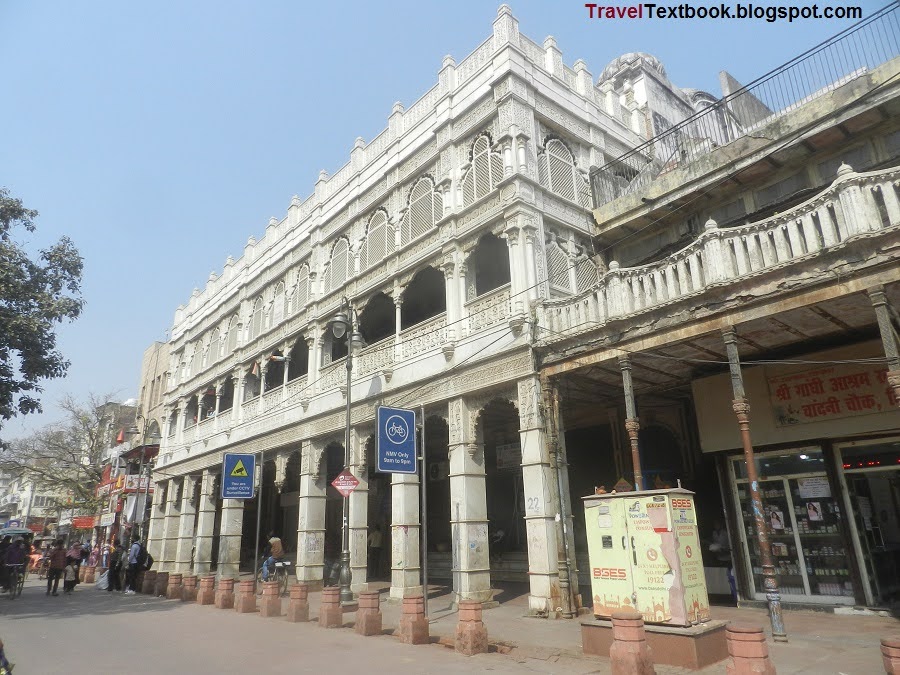
Mahavir Bhavan is one of the worship place of Shwetambara Jains. It was built in 1910 by Late Shri Gokul Chand Nahar.
This building houses many rare handwritten manuscripts and religious books. There is a beautiful white marble staircase. The main hall of the building is used for conducting prayer gatherings. It also has a library.
How to go: It is located about 80 meters from Annapurna Bhandar towards west on the right side.
You can eat Dahi Bhalla and Aloo Tikki at Natraj Dahi Bhalle Corner.
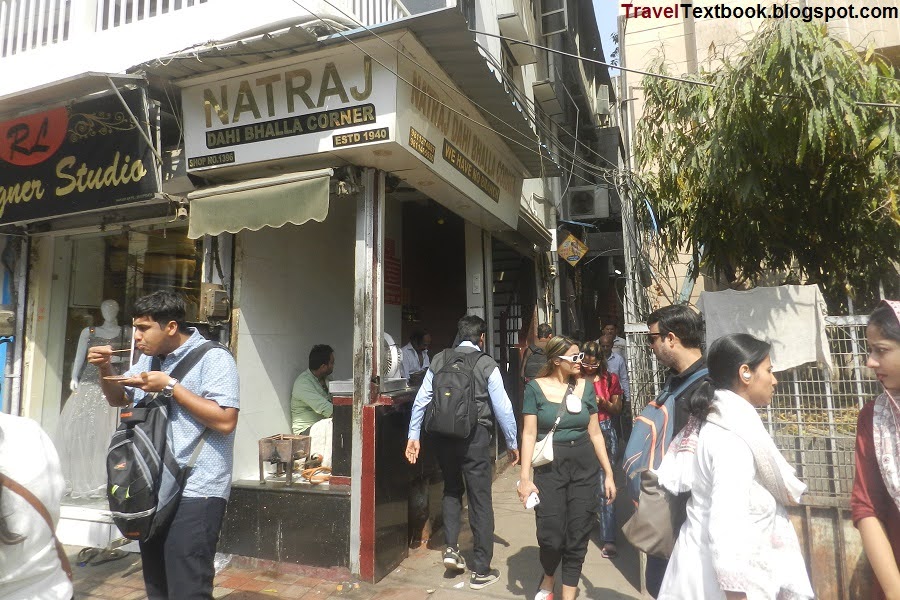
It was established in 1940. Famous for Dahi Bhalla Balls (60 Rupees) and Aloo Tikki (60 Rupees). The shops open from 11 AM to 8 PM every day. It is located about 40 meters from Mahavir Bhawan towards west on the same side.
Ghantaghar Chandni Chowk
Town Hall

The Old City of Delhi was founded by Princess Jahanara Begum (23 March 1614 – 16 September 1681), the second child of Emperor Shah Jahan. She built an elegant caravan Sarai with a garden behind.
Serai was probably demolished before 1857. The Serai was replaced by the Victorian-Edwardian architectural building now known as the Town Hall, built in 1860-65 as a center for Europeans. It was originally called the "Lawrence Institute". The institute had a durbar hall with public library and reading rooms. The pool in the middle of the square was replaced by a 128-foot-tall clock tower around 1870. Hence the palace is known as "Ghantaghar" to the locals.
The bronze statue of Queen Victoria stood between the Tower and the Municipal Building in 1902 and was later shifted to the Delhi College of Art.
Indian National Flag hoisted at Chandni Chowk, 15 August 1947 at Delhi Town Hall, Swami Shraddhanand (An Indian freedom activist who was instrumental in organizing and purifying a Hindu reform movement in the 1920s) statue in front.
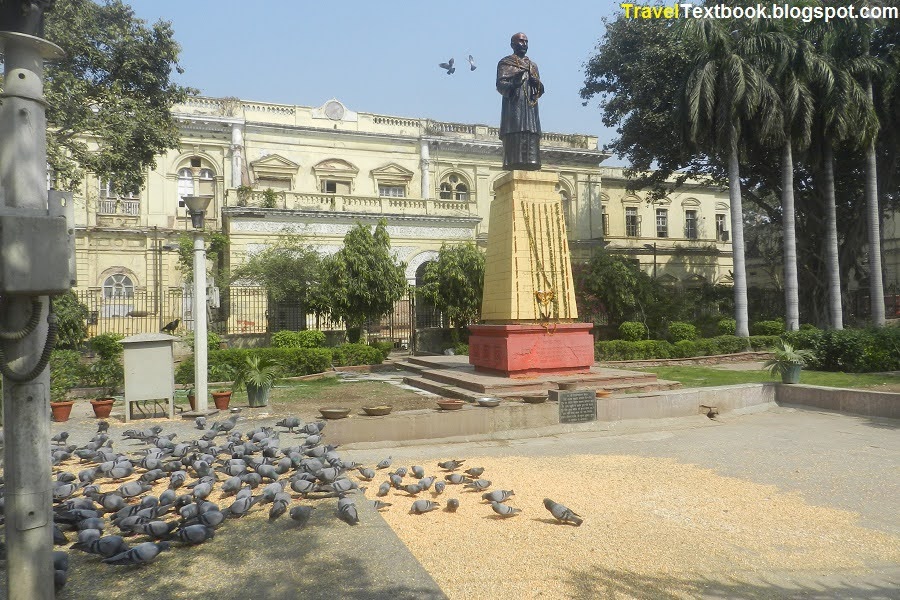
In 1950 the top of the tower collapsed, killing some local citizens. The structure was known as an English relic and thus was never rebuilt.
How to go: It is located about 280 meters from Natraj's Dahi Bhalle towards west.
Shahi Bagh Wali Masjid
Mosque
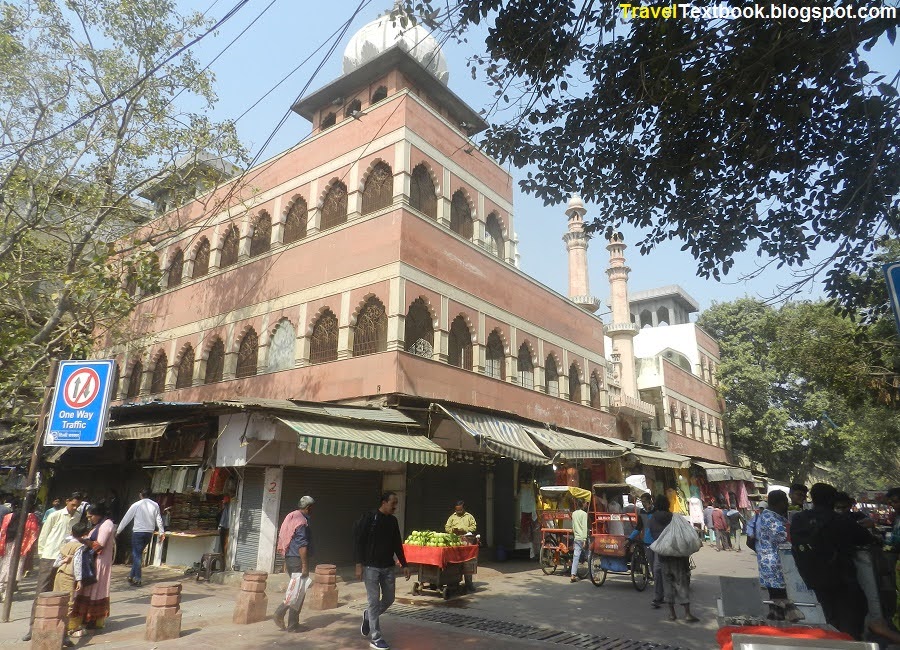
The entrance to the mosque is from the east side road of the mosque.
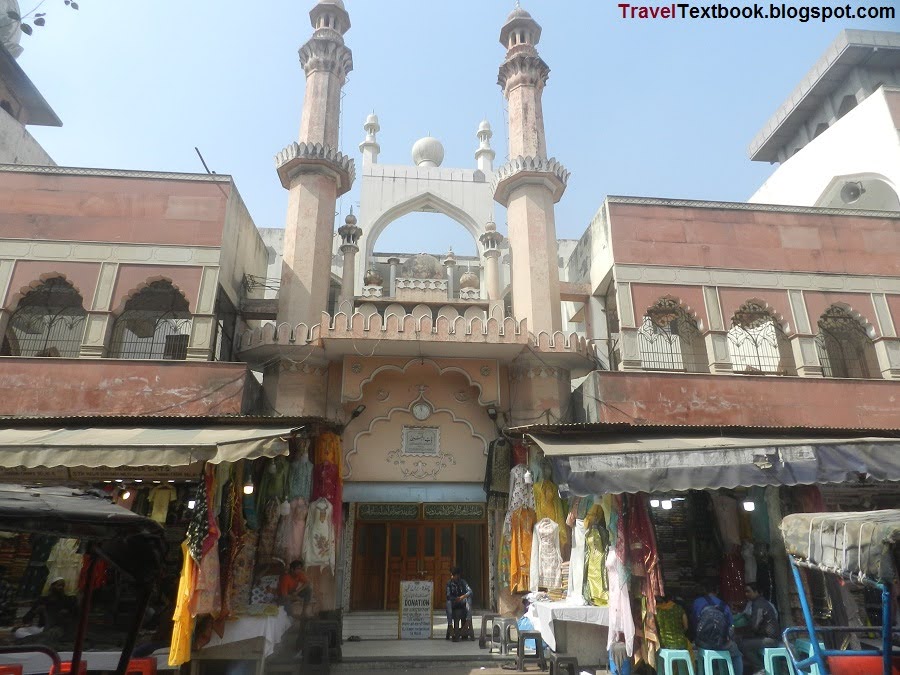
How to go: It is located west side of Ghantaghar.
You can eat Motichur Laddu (sweets) at Tewari Brothers.
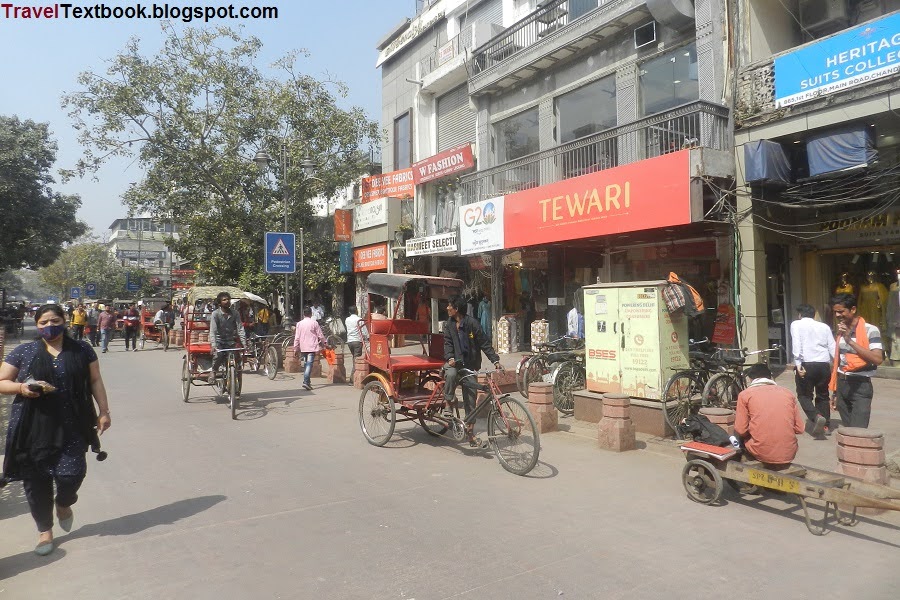

It was established in the 1930s in Kolkata. They shifted here to Delhi and started here since 1986. Known for Motichur Laddu. They have 4 laddu box at 80 Rupees, and also have big box. It is located few meters west of Shahi Bagh Wali Masjid.
Chunnamal Haveli
Mansion
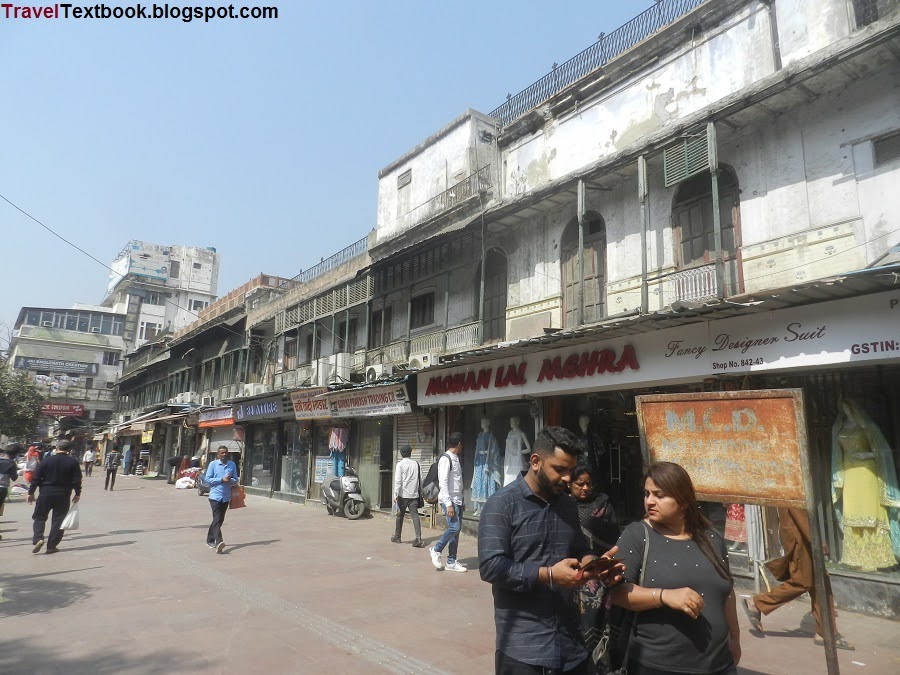
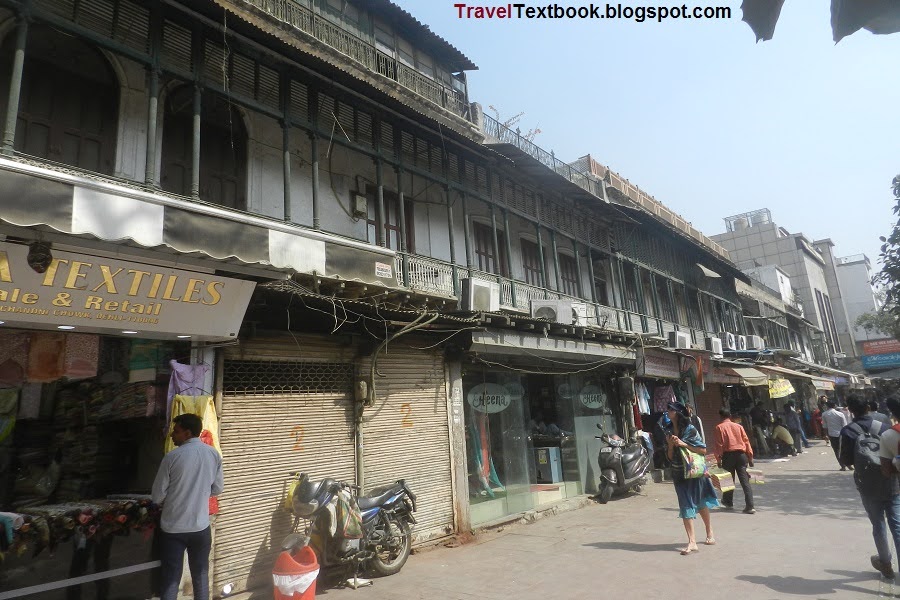
During the Indian Rebellion of 1857, Lala Chunnamal was one of the richest hindus in Delhi, keenly reading which way the wind was blowing and made a huge fortune to supply the British. The British ordered the forcible removal of all Muslims from the city of Delhi.
After the Muslims were expelled from the city in 1857, the mosque was auctioned by the British. Lala Chunnamal bought the mosque at an auction with a huge sum of money. Lala Chunnamal preserved the mosque without demolishing it. He just kept the mosque locked and waited for the time to change.
Twenty years later, in 1877, the British lifted the ban on Muslims entering (or living in) Delhi. During this time, the mosque was acquired by the British and made available for Muslims to pray. Lala Chunnamal family received a property in four villages in exchange for the mosque.
Chunnamal Haveli was built in 1848. However, parts of it were added in 1864. Today, this ancestral Chunnamal Haveli is the last surviving palace in a well-preserved state. It is spread over an acre of land, with 150 rooms built over three floors. The palace is surrounded by 139 shops. Descendants of Lala Chunnamal still live in Chunnamal Haveli.
How to go: It is located about 30 meters from Tewari Brothers towards west.
You can eat Bedmi Pooree with Aloo Sabzi with crisp Jalebi or Imarti at Shiv Mishthan Bhandar.

It was established in 1910. It is located about 150 meters from Channamal haveli towards west.
You can eat Kaju Burfi, Sohan Halwa, Karachi Halwa, Badam Sew, Pinni, Patisa, Besan Laddoo at Meghraj and Sons.

It was established in the 1900. It is located southwest end of Chandni Chowk street.
You can eat Besan ke Laddoo, Ghee Patisa and Ghevar at Chaina Ram Sindhi Halwai.

It was established in 1901. It is located left (south) side of Fatehpuri Masjid gate, which is west end of Chandni Chowk street.
Fatehpuri Masjid
Mosque
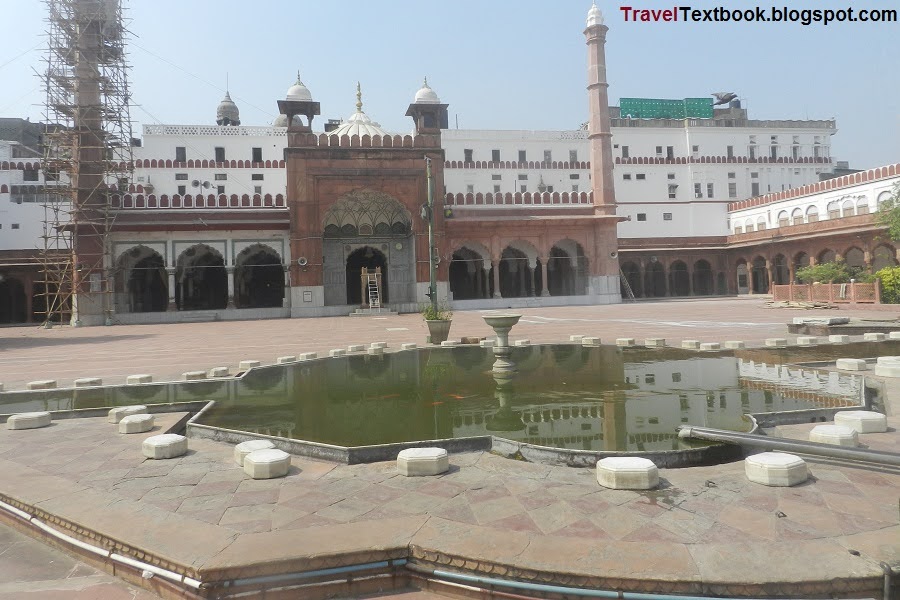
Fatehpuri Masjid was built in 1650 by Fatehpuri Begum, one of emperor Shah Jahan's wives.
The British ordered the forcible removal of all Muslims from the city of Delhi. After the Muslims were expelled from the city in 1857, the mosque was auctioned by the British. Lala Chunnamal, one of the rechest hindu at that time, bought the mosque at an auction with a huge sum of money. Lala Chunnamal preserved the mosque without demolishing it. He just kept the mosque locked and waited for the time to change.
Twenty years later, in 1877, the British lifted the ban on Muslims entering (or living in) Delhi. During this time, the mosque was acquired by the British and made available for Muslims to pray. Lala Chunnamal family received a property in four villages in exchange for the mosque
I entered the mosque through the east gate of the mosque (west end of Chandni Chalk Street).
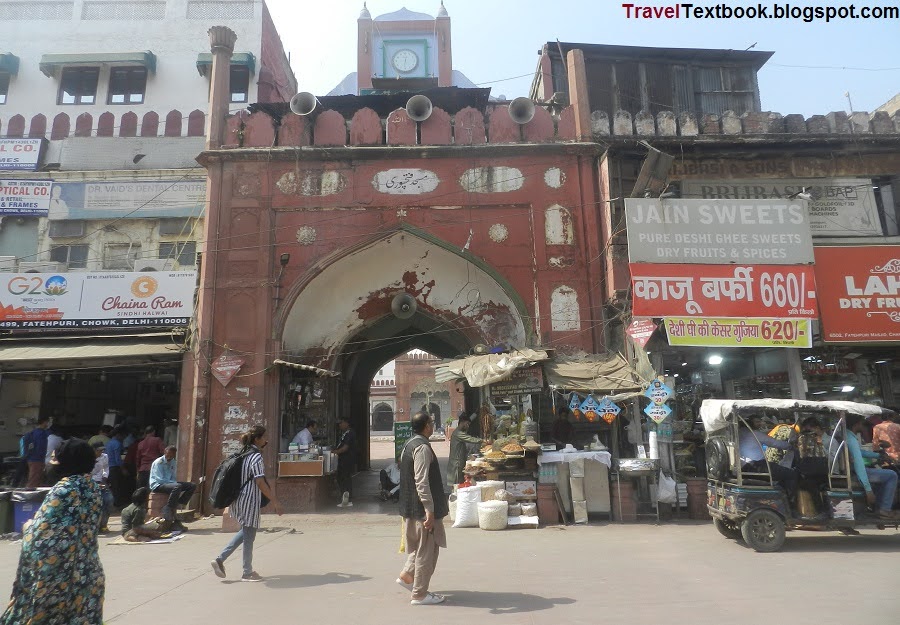
Shoes must be removed to enter the mosque. Either you can take it in your hand or keep it at the gate. Upon entering, I saw a huge yard. The main prayer hall is located at the western end of the premises.
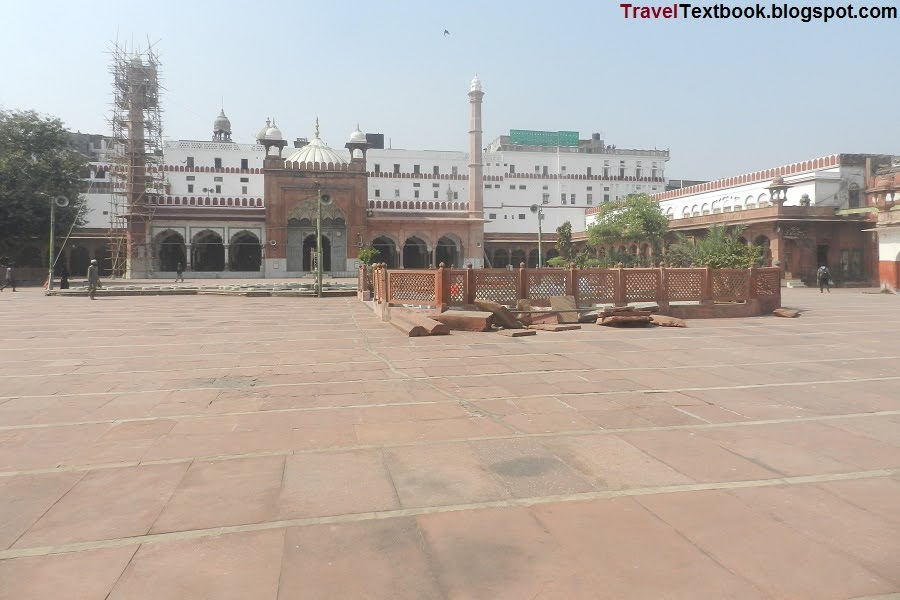
Right side (north) view of the mosque premises.
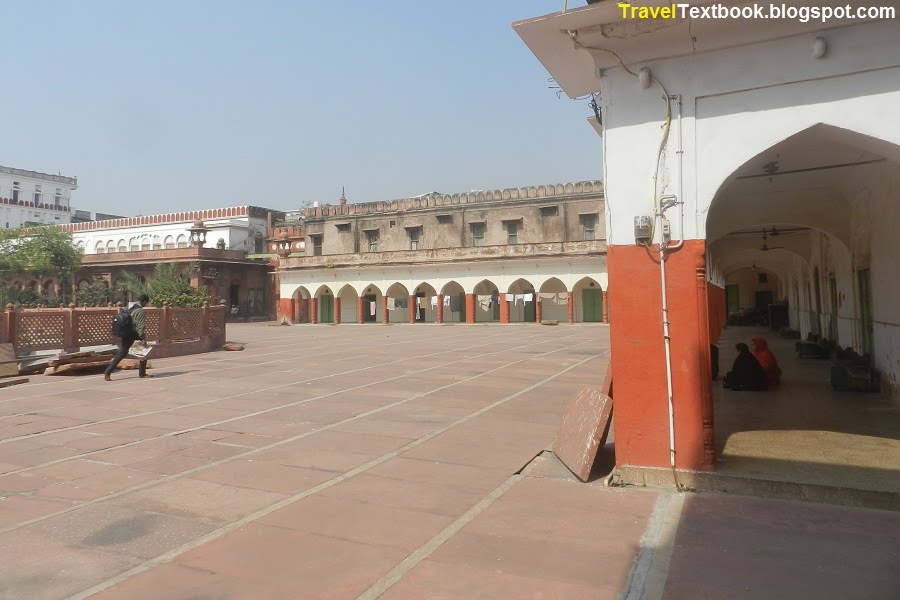
There is a entry/exit gate on the north side.
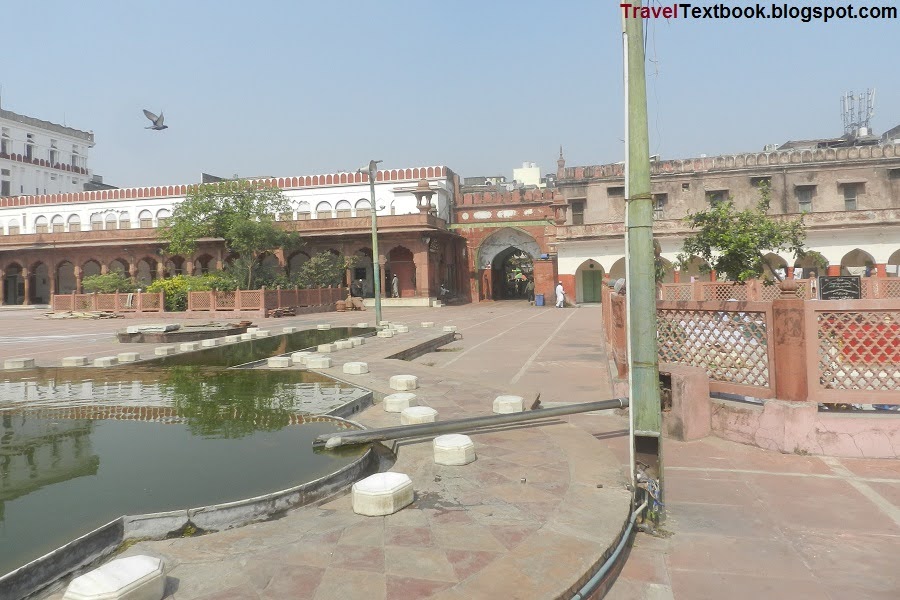
Left side (south) view of the mosque premises.
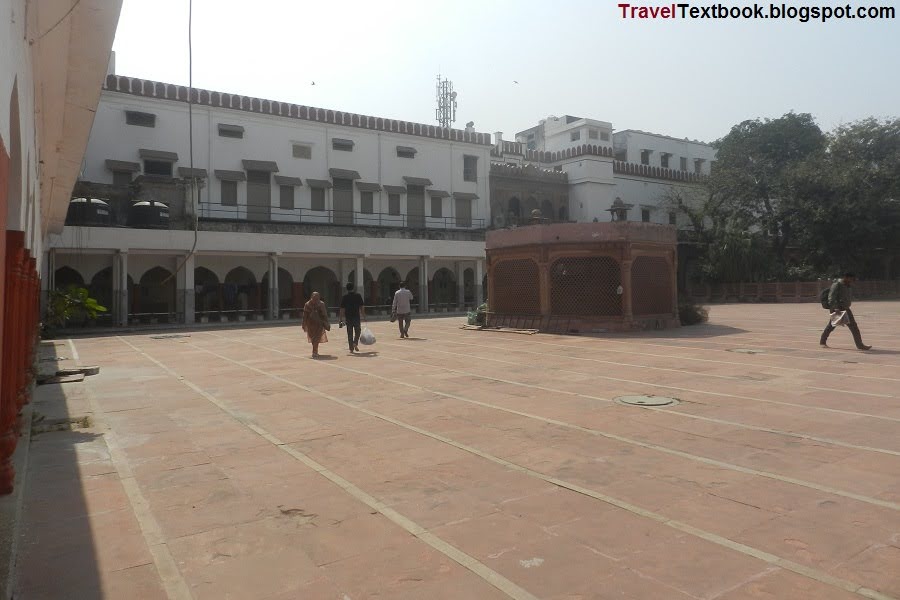
There is a entry/exit gate on the south side.

How to go: It is located west end of Chandni Chowk Street.
Khari Baoli Road
Street
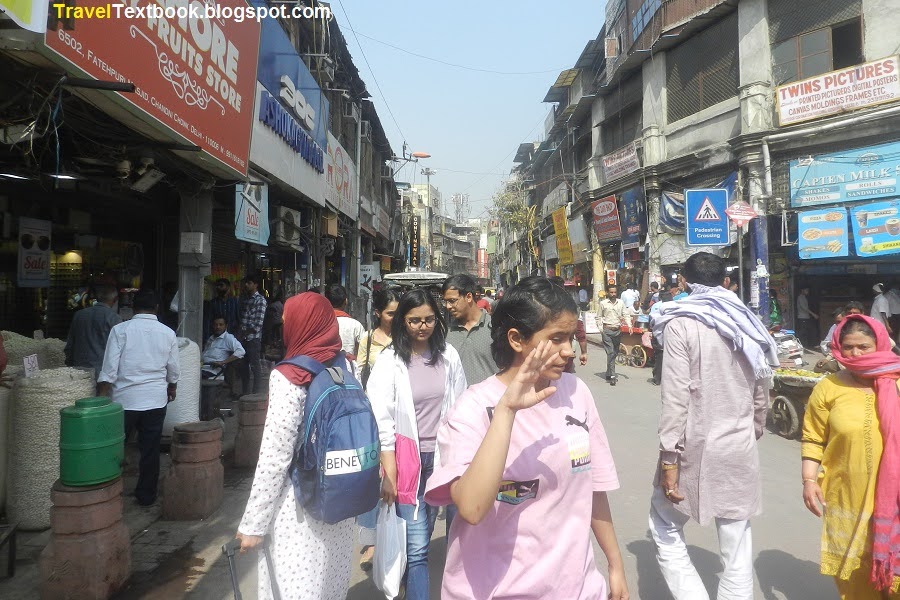
430 meters east-west street now known for its wholesale grocery and Asia's largest wholesale spice market selling a variety of spices, nuts, herbs and food products like chocolates, pickles, tea.
Baoli, meaning step well, and Khari or Khara, meaning salty. During the reign of Salim Shah, Khwaja Abdullah Lazaar Qureshi laid the foundation of the Khari Baoli well which was completed in 1551. Nothing of this baoli now remains, only the copy of the inscription of Persian text, which was preserved.
I started walking on Khari Baoli Road.
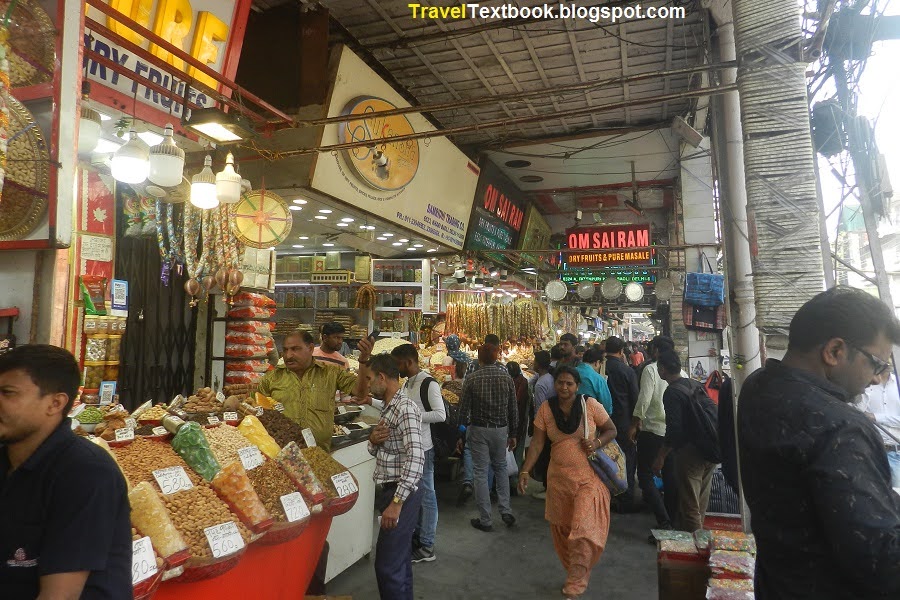
Many shops have been doing business here for many years. Such as Mehar Chand and Sons wholesale and retail shop since 1917 for tea, spice, Dry fruits.

"Gadodia Market" was built by wealthy merchants in 1920s has one of the numerous spice stores and is Asia's largest wholesale spice market.
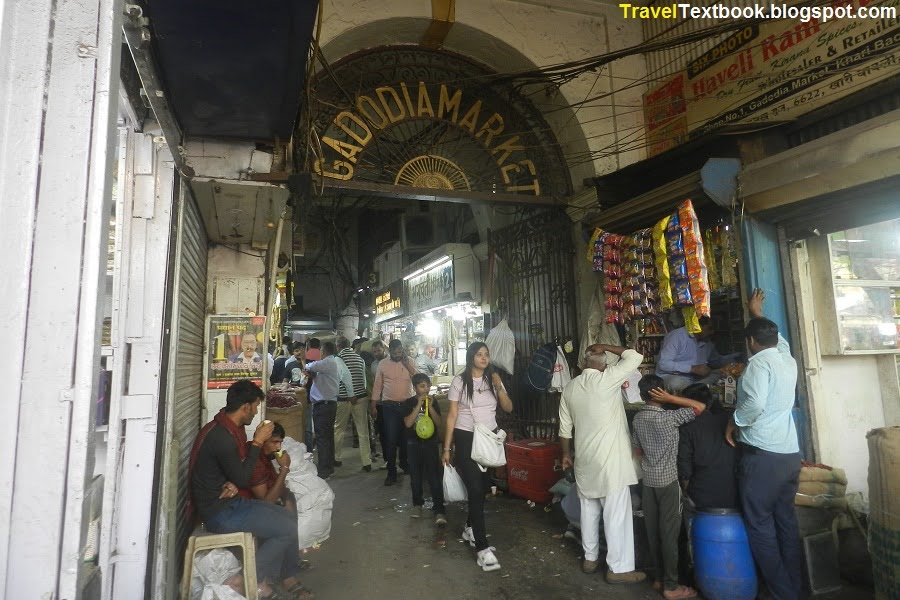
Goyal Rice House since 1932 for Dal Rice and spices.
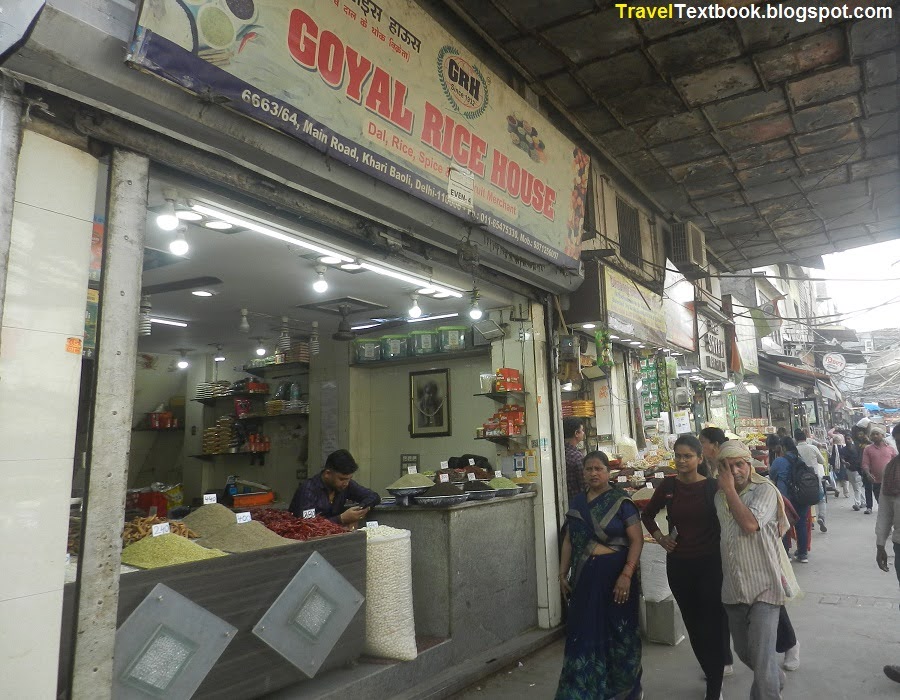
Makhan Lal is a sweet shop since 1940. Famous for Halwai.

One famous pickle shop which originally started in the 1860s is that of Harnarains, and currently operates under the name Harnarains International. Even Jawaharlal Nehru and Indira Gandhi also the customer of this shop.
How to go: Take a right (north) turn at the Fatehpur Masjid Gate (at the west end of Chandni Chowk Road). A few meters later, a road turns left (west), this is the start of Khari Baoli Road, and the road continues west for about 420 meters till GB (Garstin Baston) Road.
Lahori Gate Haveli
Landmark
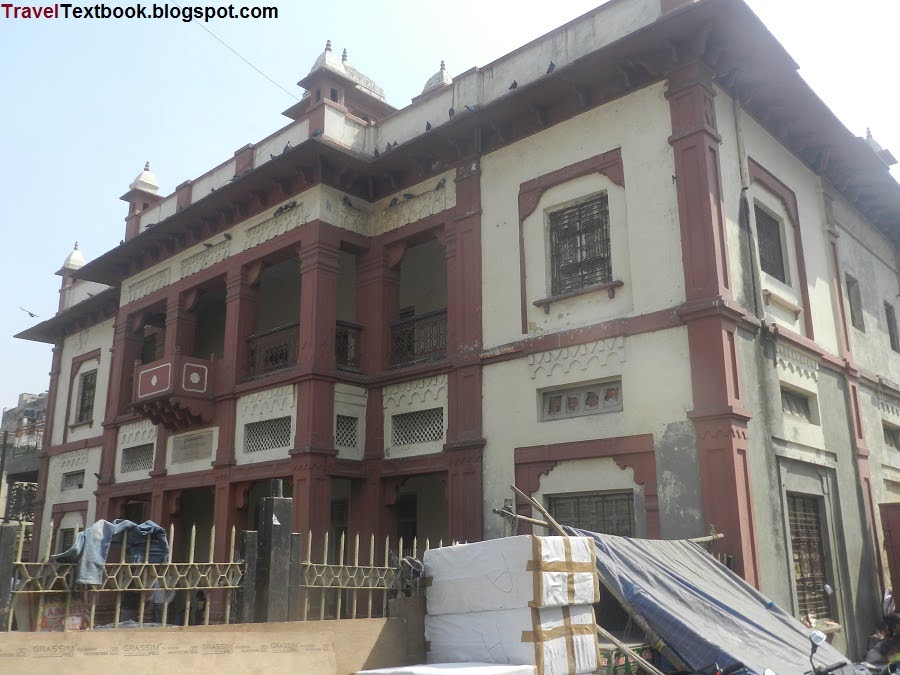
It was built in 1929 as a palatial haveli at Lahori Gate. Later it was used as a dispensary until 2004. Then from February, 2004, it was a museum of cultural history named "Walled City Museum", and now an abandoned building.
How to go: It is located West end of Khari Baoli Road.
Masjid Lahori Gate
Mosque

The constructing date of the mosque is unknown.
How to go: It is located west of Lahori Gate Haveli.
Mirza Ghalib Haveli
Museum
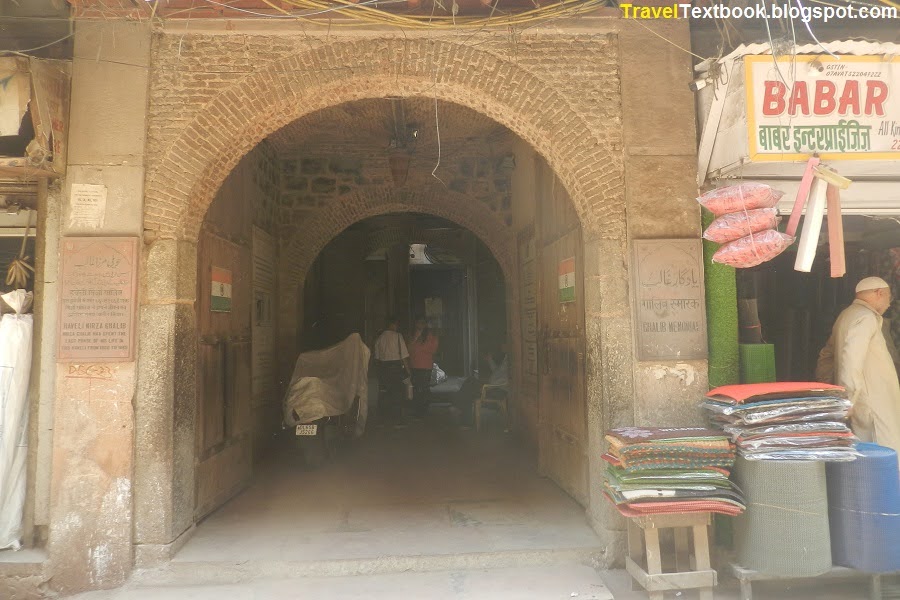
It was the residence of the Urdu poet Mirza Ghalib (1797-1869).
After Ghalib arrived from Agra, he was given the house by Hakim, a physician believed to be an enthusiast of his poetry. He lived from 1860 until his death in 1869. He composed his Urdu and Persian 'Diwan' while staying in this haveli. He died in this house on February 15, 1869. He was buried near Nizamuddin Auliya Dargah, which is known as Mirza Ghalib Tomb.
After the poet's death in 1869, Hakim used to sit there every evening, not allowing anyone to enter the building. Later there were shops in the place till 1999 and then the government acquired a part of it and renovated it. It was given a special touch by using Mughal Lakhori bricks, sandstone and a wooden entrance to recreate the 19th century period.
When I entered, I saw that there was a door in front, but it was split in two. There is a hotel on the right side of the building by the stairs. It is a budget hotel to stay. The left part is the entrance to the Mirza Ghalib Museum.
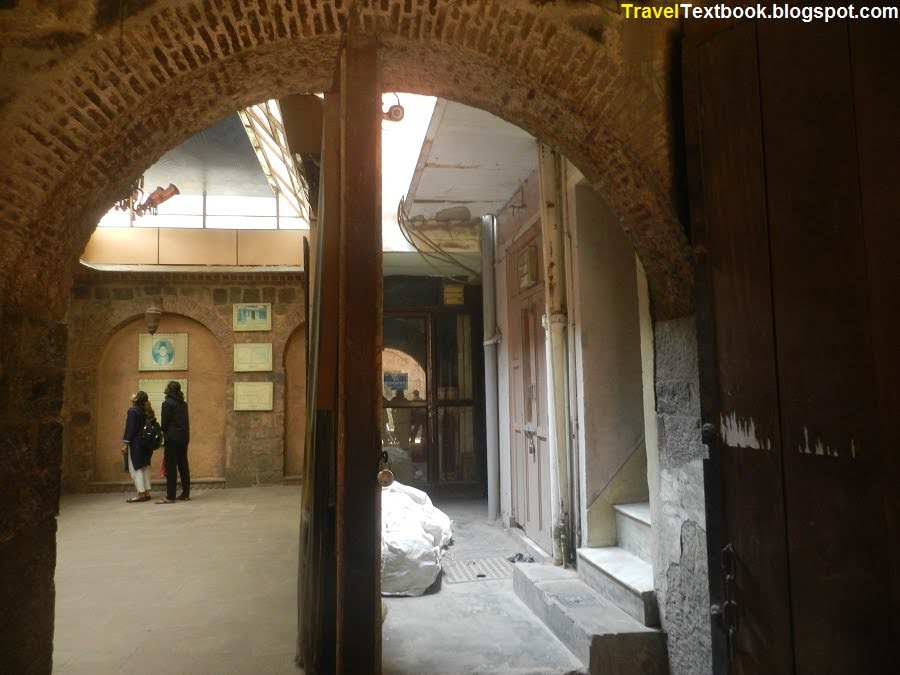
Before I enter I saw a corridor on the right led to a small room.
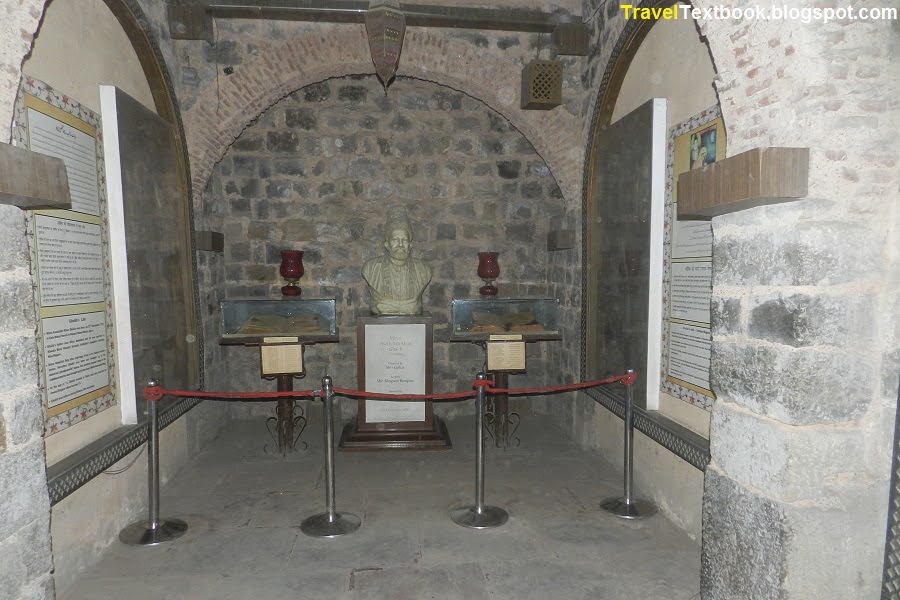
Then I entered the museum on the left side.
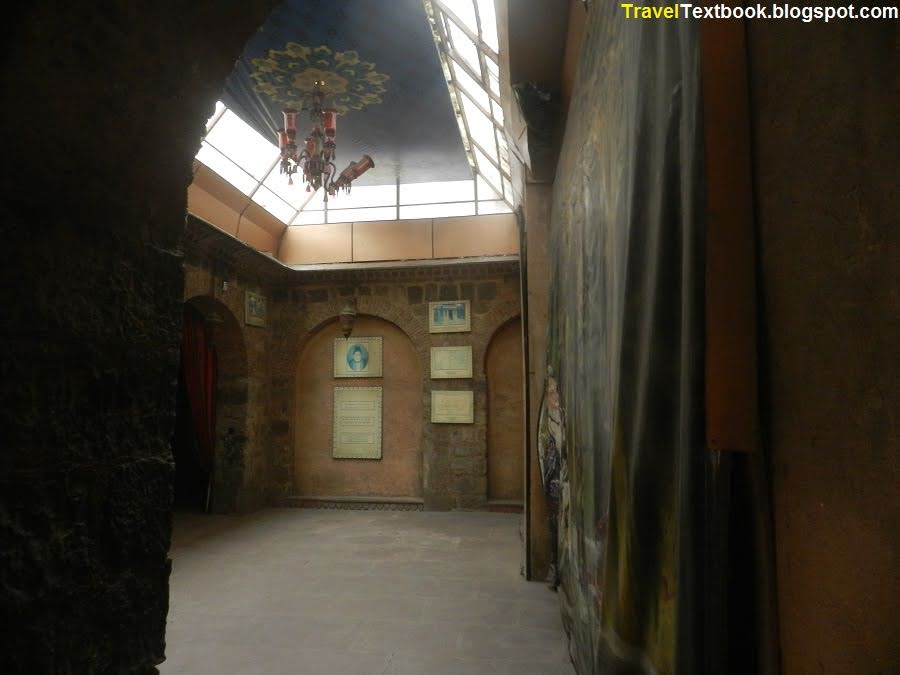

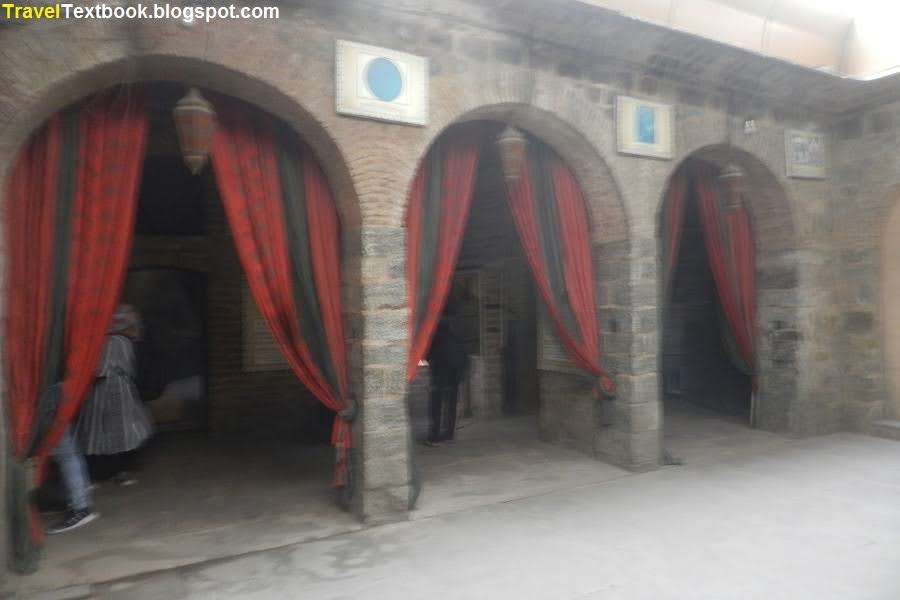
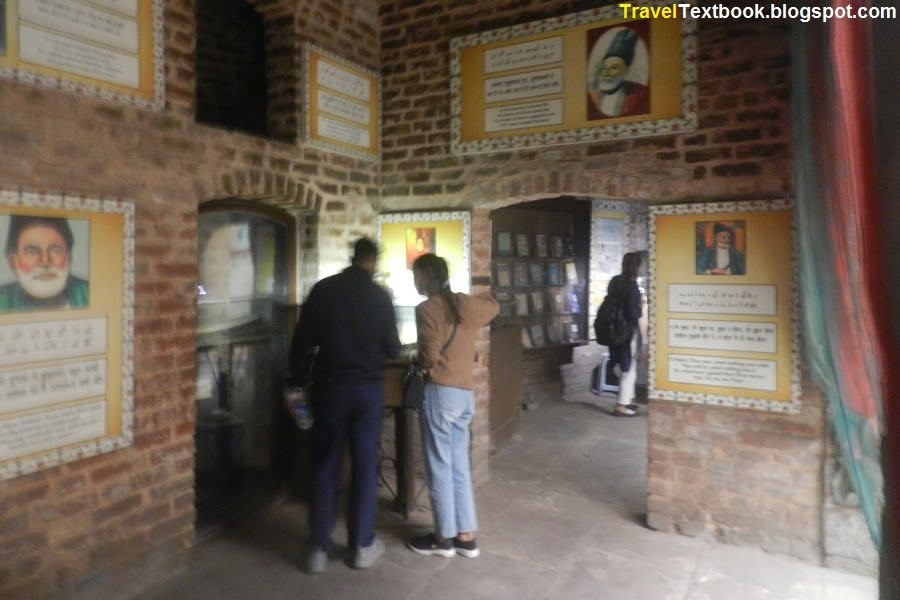
Visiting Time: Tuesday to Sunday - 11 AM to 6 PM. Monday remains closed.
Entry Fee: Free.
Photography: Allowed.
How to go: From the west side of Chunnamal haveli at Chandni Chowk Street, I cross the road to the south and enter a street called ‘Ballimaran’. I walked about 220 meters south. Then turned right (west) to Qasimjan street, and walked about 20 meters, and found the haveli on my left.
Paranthe Wali Gali
Street
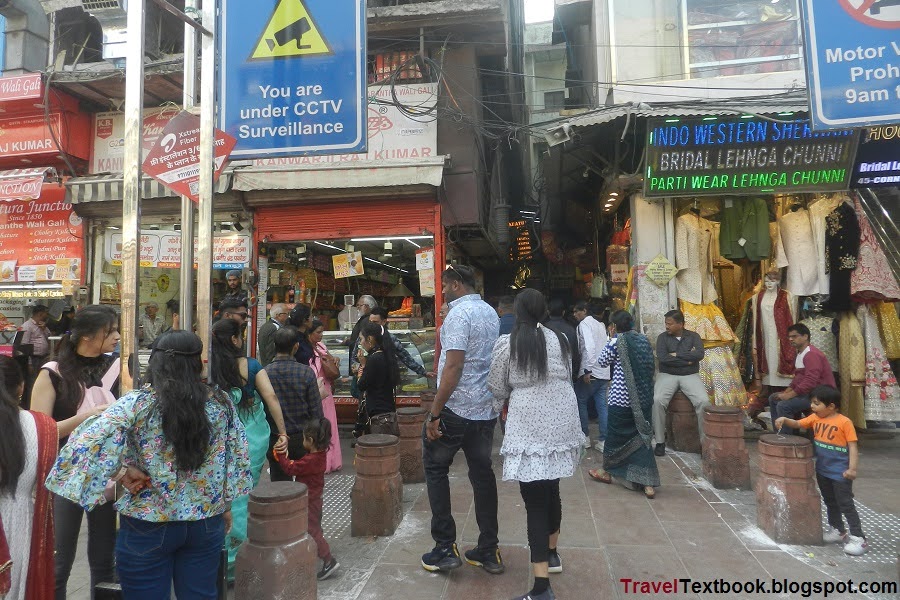
A 60 meters narrow walkway noted for its series of shops selling paratha, an flatbread.
The street was established in 1650 during the reign of Mughal Emperor Shah Jahan and designed by his daughter Jahanara Begum. Earlier, this lane was known only for its silverware shops, before Parantha shops moved in starting in the 1870s, although many saree and jewellery shops remain.
By 1911 this street was named Paranthe Wali Goli. In the post-independence years, Jawaharlal Nehru, Indira Gandhi and Vijaya Lakshmi Pandit visited this lane to have their paratha. Bollywood actor Akshay Kumar lived in that area.
Before I enter the walkway, saw 3 small shops on the left side established in 1850 named Kanwarji's Bhatura Junction, Kanwarji Dalbiji Wala and Kanwarji's Confectioners.
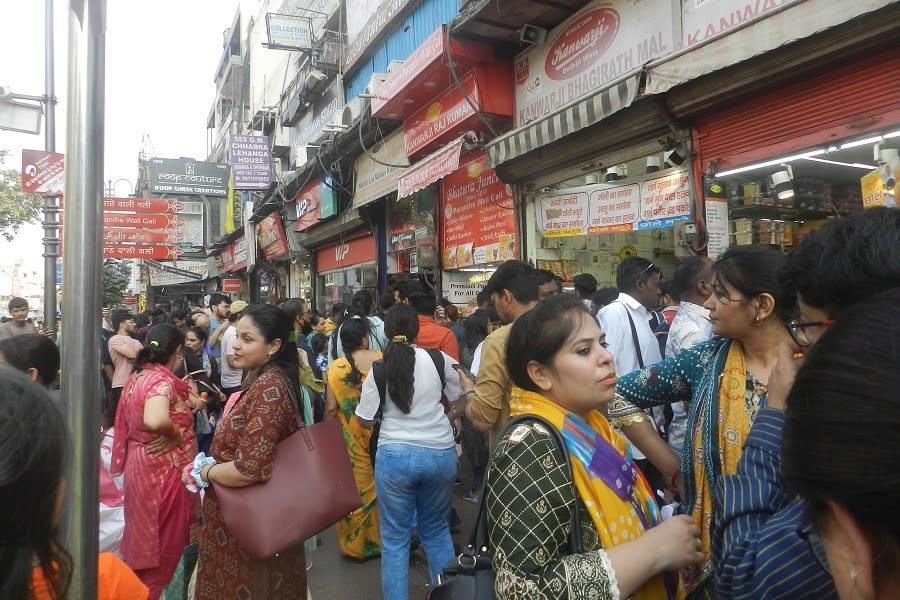
Then I entered the walkway. Babu Ram Devi Dayal, the shop was established in 1889.
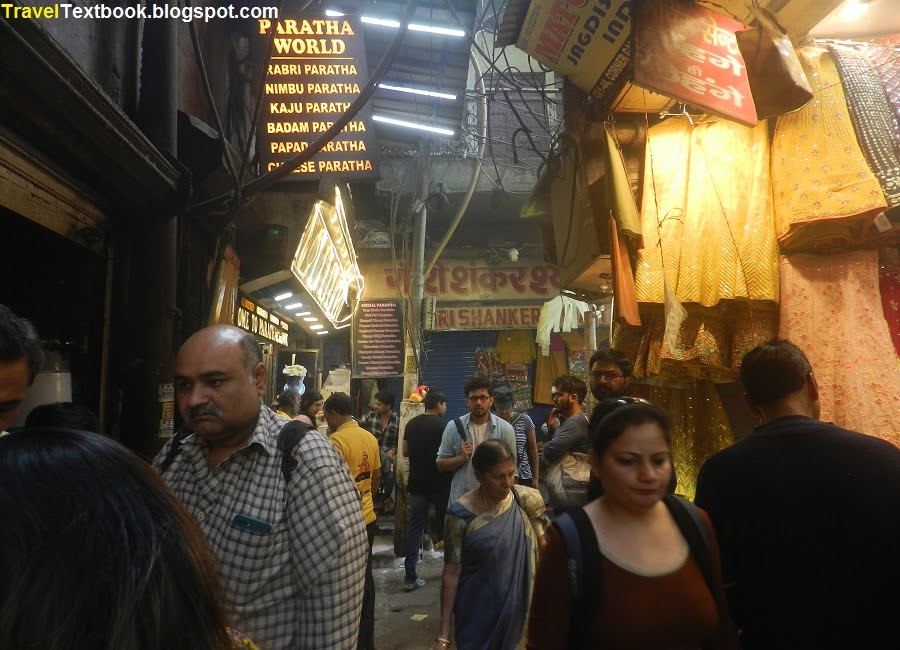
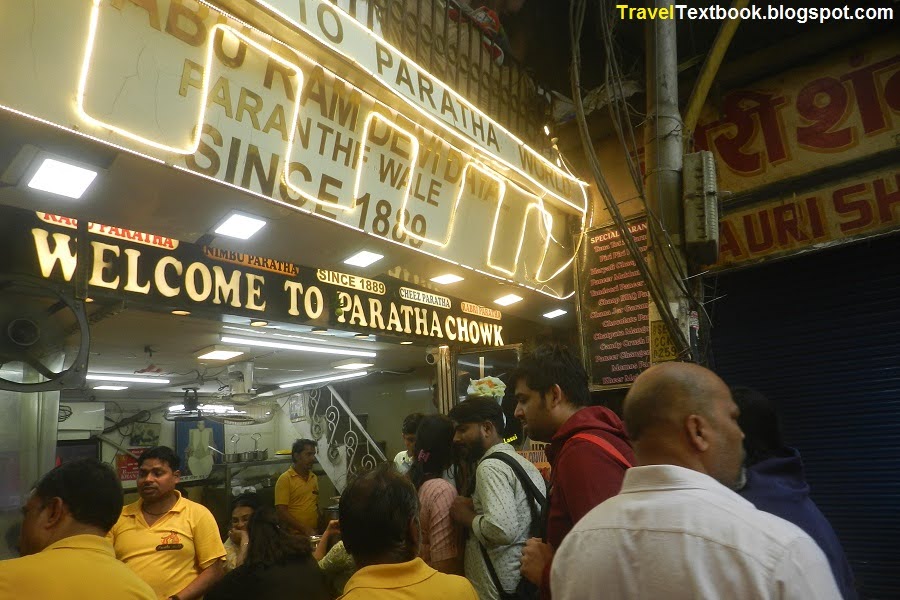
Then I turned to right.

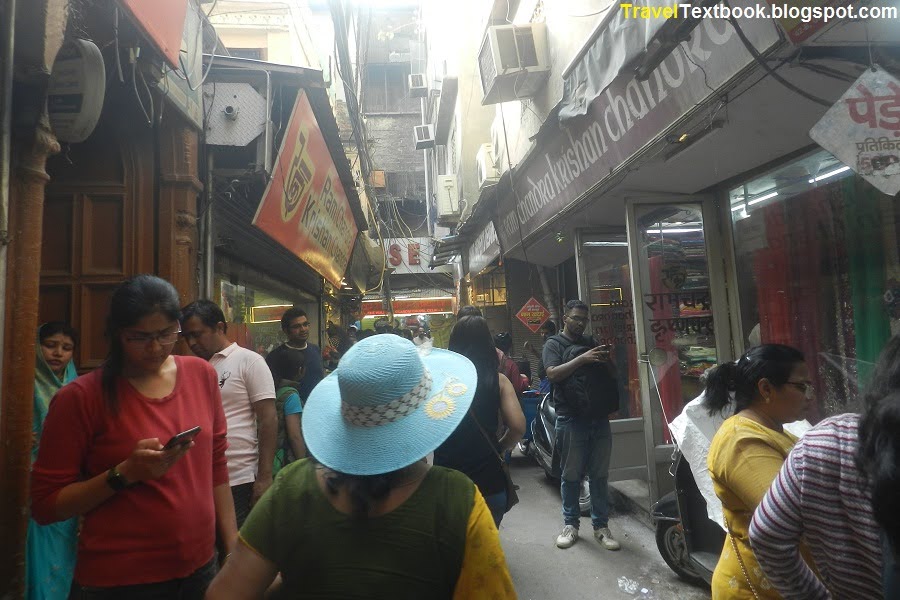

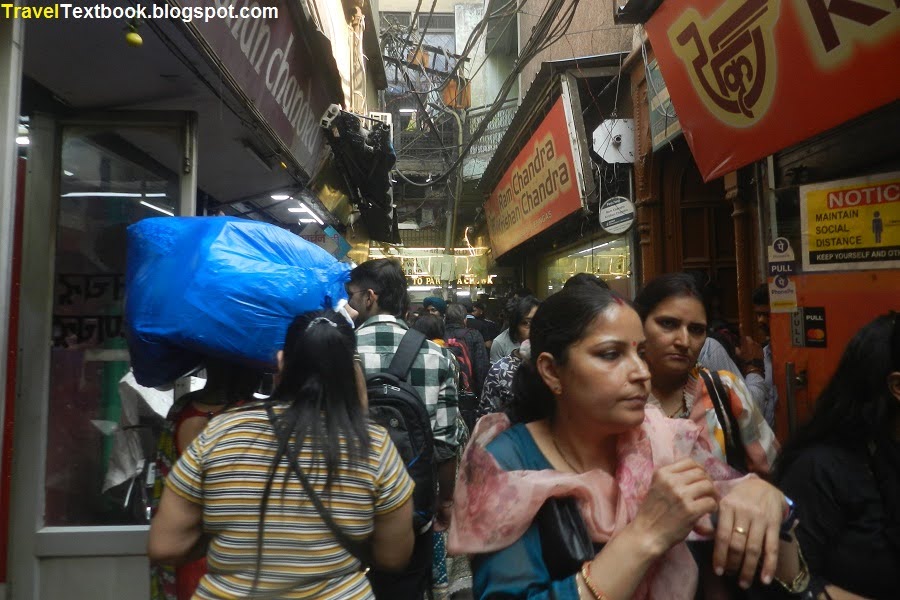
At the end I turned left. There is a shop named Gaya Prashad Shiv Charan, established in 1872.
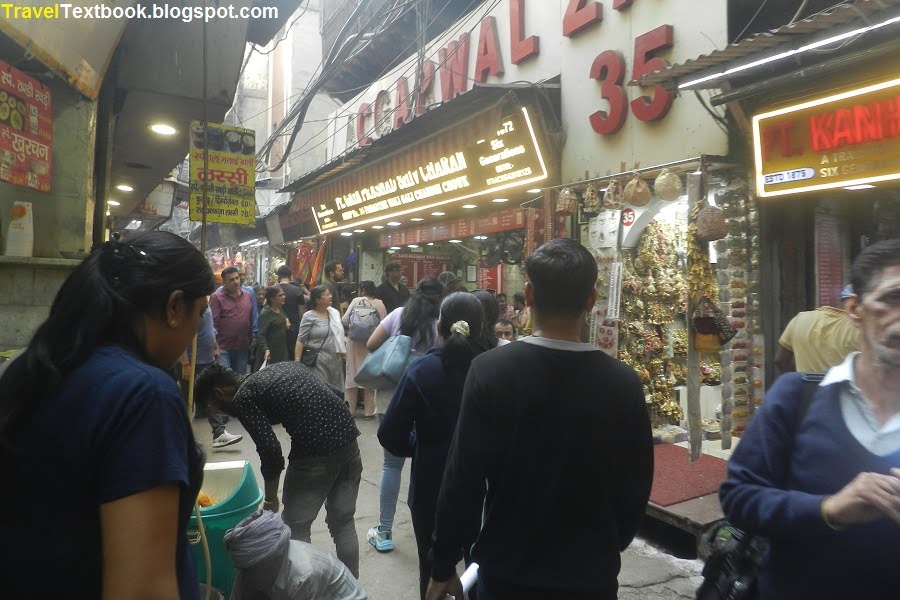
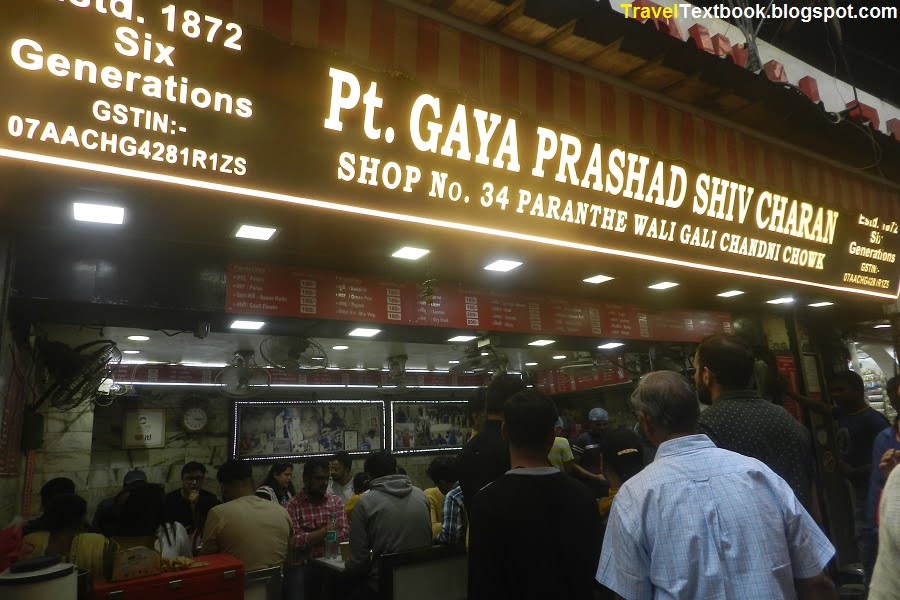
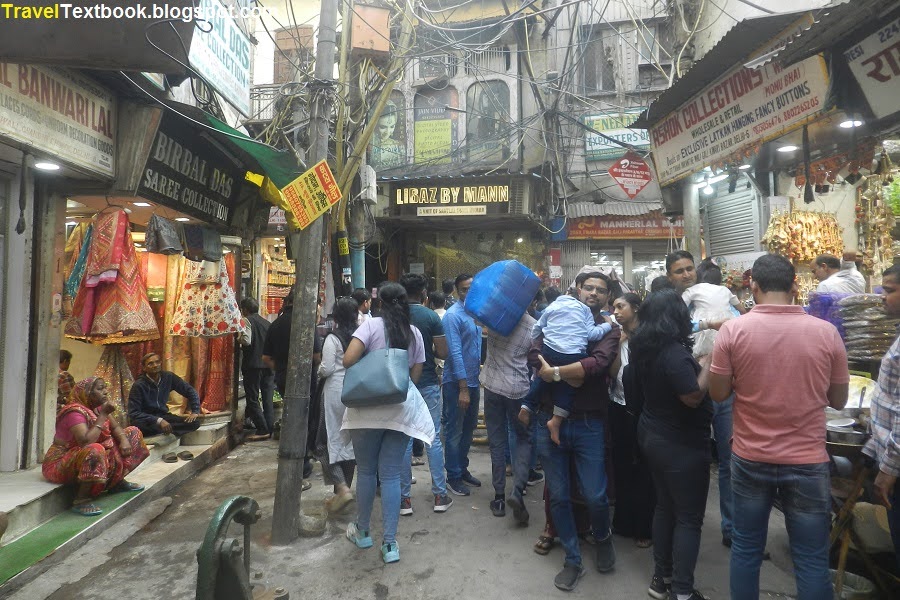
At the end of Paranthe Wali Gali, one road goes to right (west) and another is left (east). Left side road is called Kinari Bazar road. It ends at Dariba Kalan road.

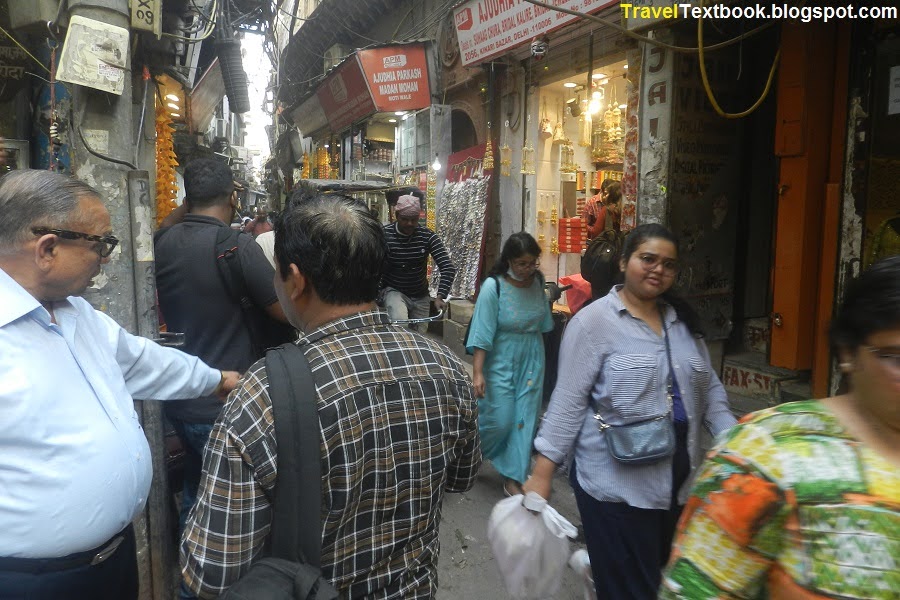
How to go: It is located about 500 meters from the entrance of ‘Ballimaran’ street towards east and 180 meters from Gurdwara Sis Ganj Sahib towards west. Just opposite (south) of Central Bank of India.
Naughara Mansions
Mansions
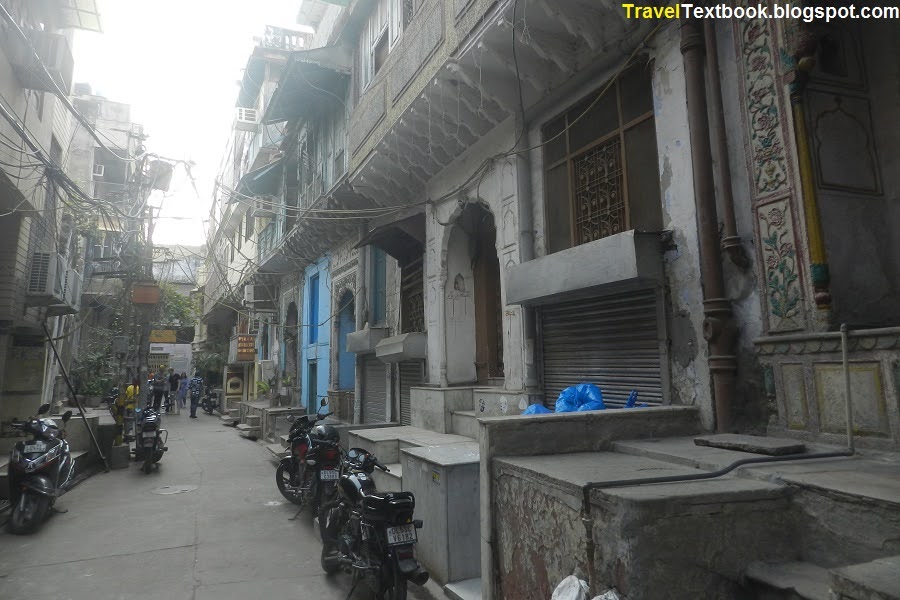
Naughara Gali is a road with nine continuous houses of 18th century with brightly painted floral designs on their facades.
I walked about 80 meters from the south end of "Paranthe Wali Gali" to the left (east) along Kinari Bazar Road.

I saw the small gate on the right.
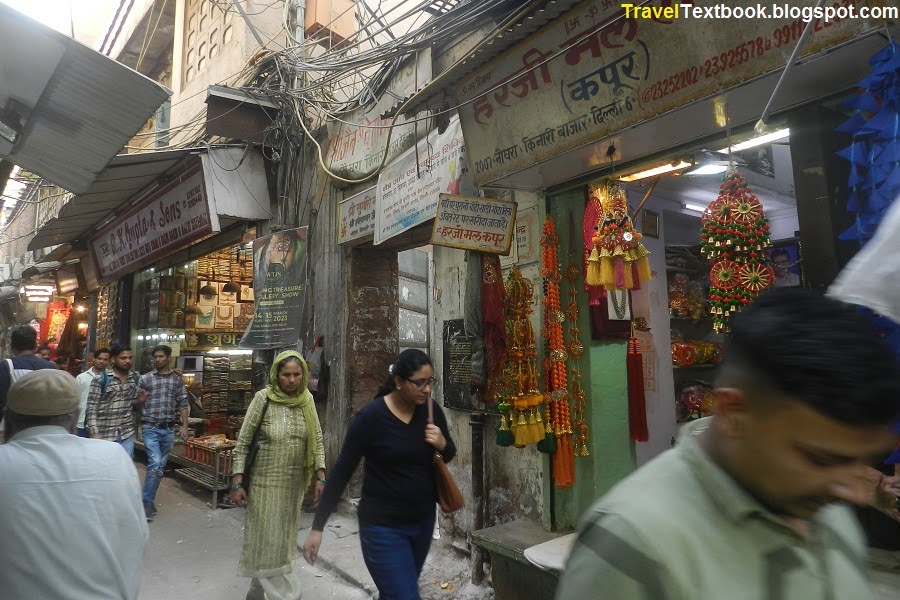

Entering the gate, I saw a total of 9 houses one after the other on the right side. The buildings have old designed facades. At the beginning of street, there is a office of Atma Prakash Aggrawal, houses numerous antiques, which looks like an antique shop.
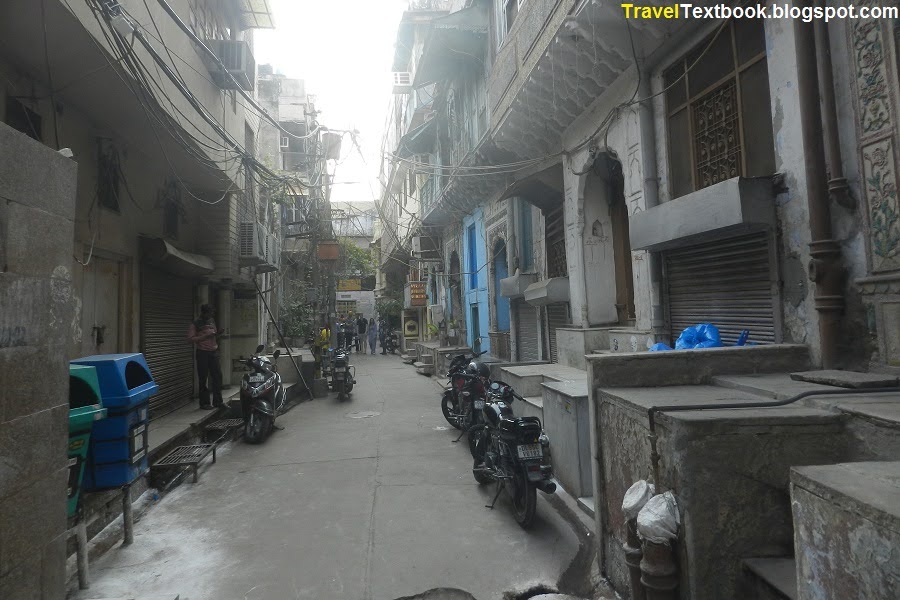

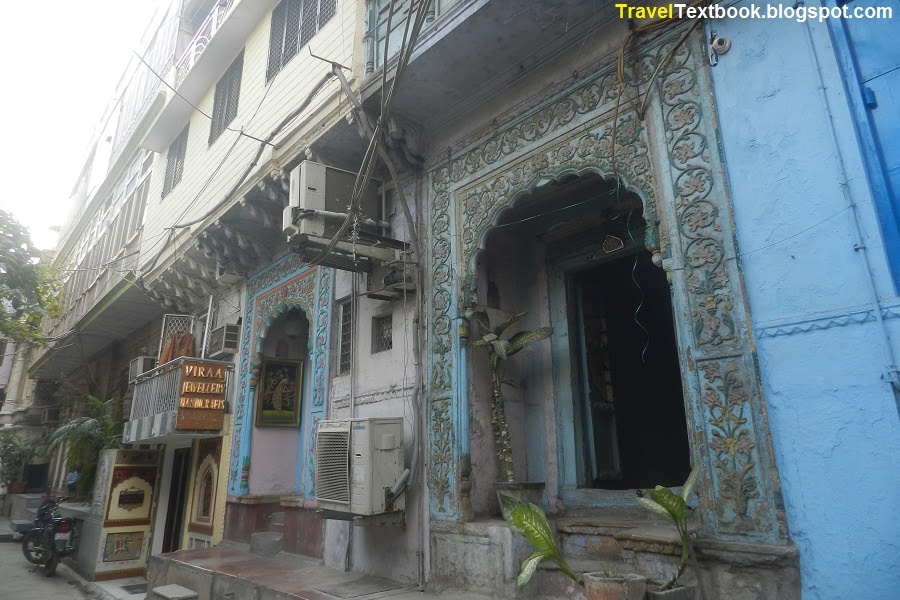
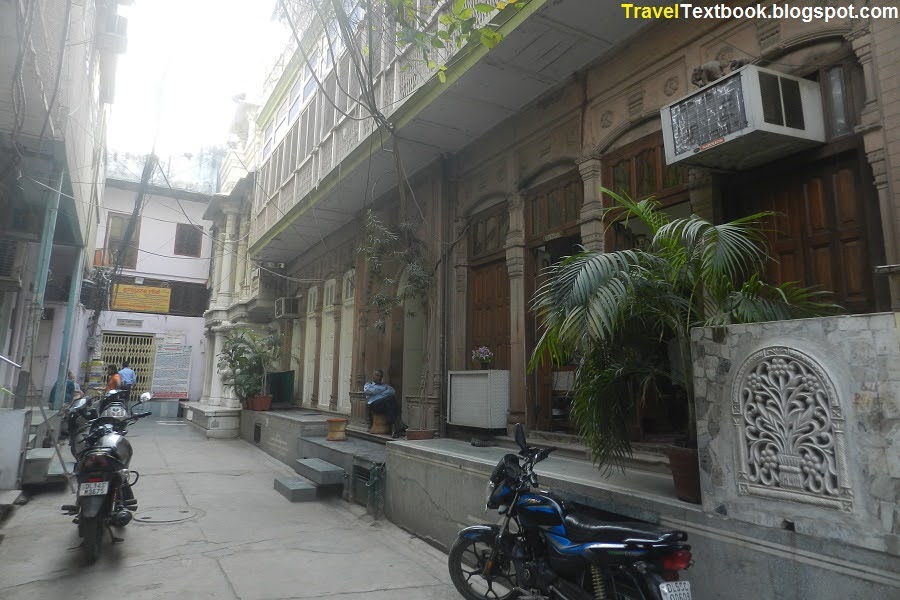
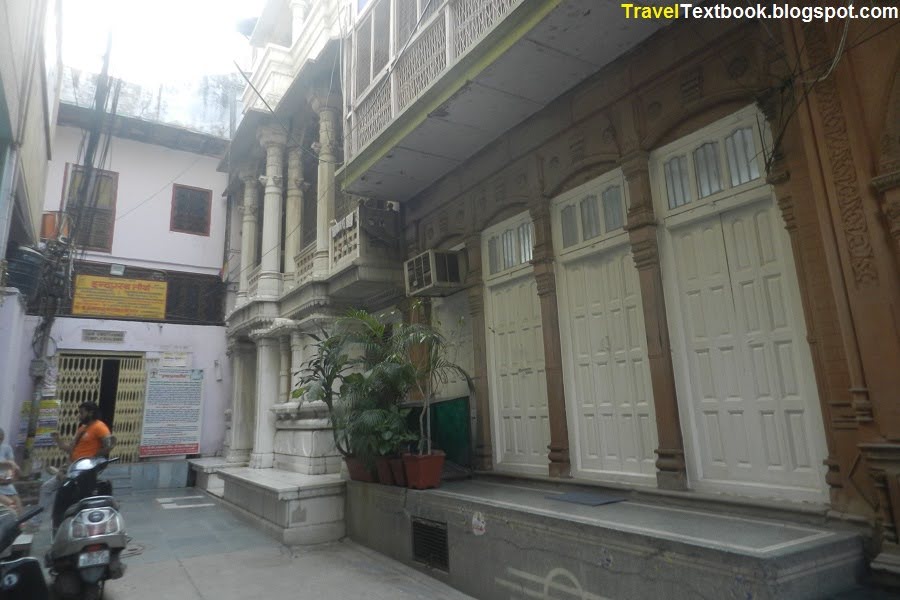
At the end of the street is a white marble Jain Svetambara temple, a museum on the ground floor that houses rare manuscripts embroidered with pure gold and silver thread and a black image of Lord Parasanath in rare kasauti stone on the first floor.

How to go: It is located about 80 meters from the south end of Paranthe Wali Gali towards left (east) through Kinaari Bazaar street. A gate will see on the right.
Eat Kurchan at Hazari Lal Khurchan Wale.


This shop, established 90 years ago, makes khurchan means ”scraped leftovers". Boil the milk, scrape off the cream as it appears on the top, and eventually mix it powdered sugar. It is located about 190 meters from Naughara Mansions towards east through Kinaari Bazaar road. The shop is located on the right.
Golden Haveli Dharampura
Hotel
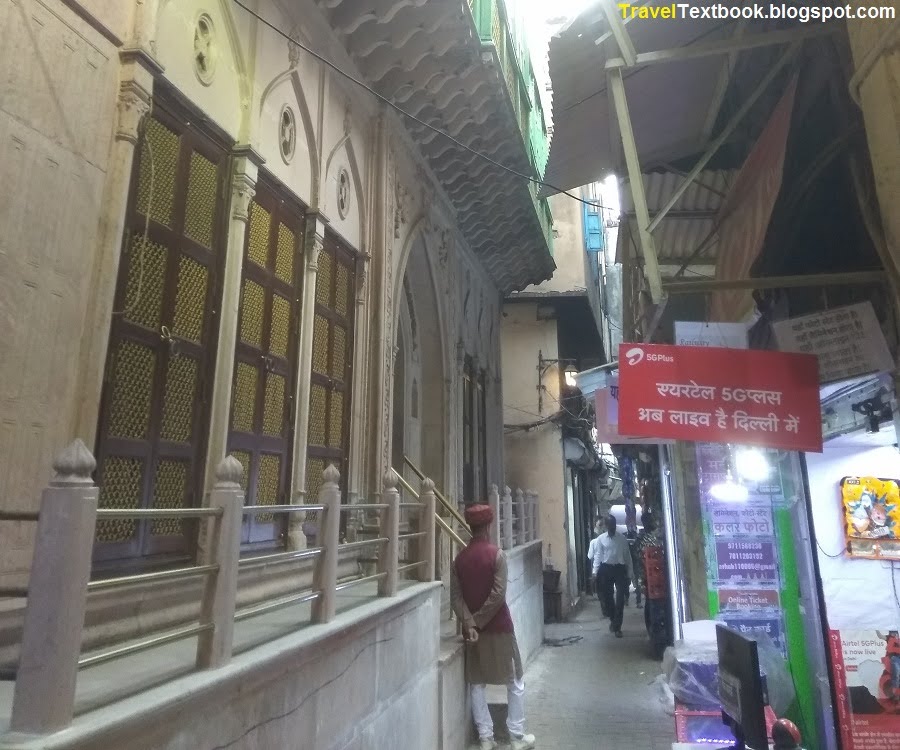
It was built in 1887. It was bought by BJP leader Vijay Goel and renovated into a modern 14-room 5-star hotel with a restaurant called Lokhaur.
Room Rent: Per night including breakfast for two - 11874 Rupees to 12874 Rupees excluding taxes.
How to go: West side from Hazari Lal Khurchan Wale, a street goes to south. I walked about 170 meters and found the hotel on the left.
Jain Naya Mandir
Jain Temple
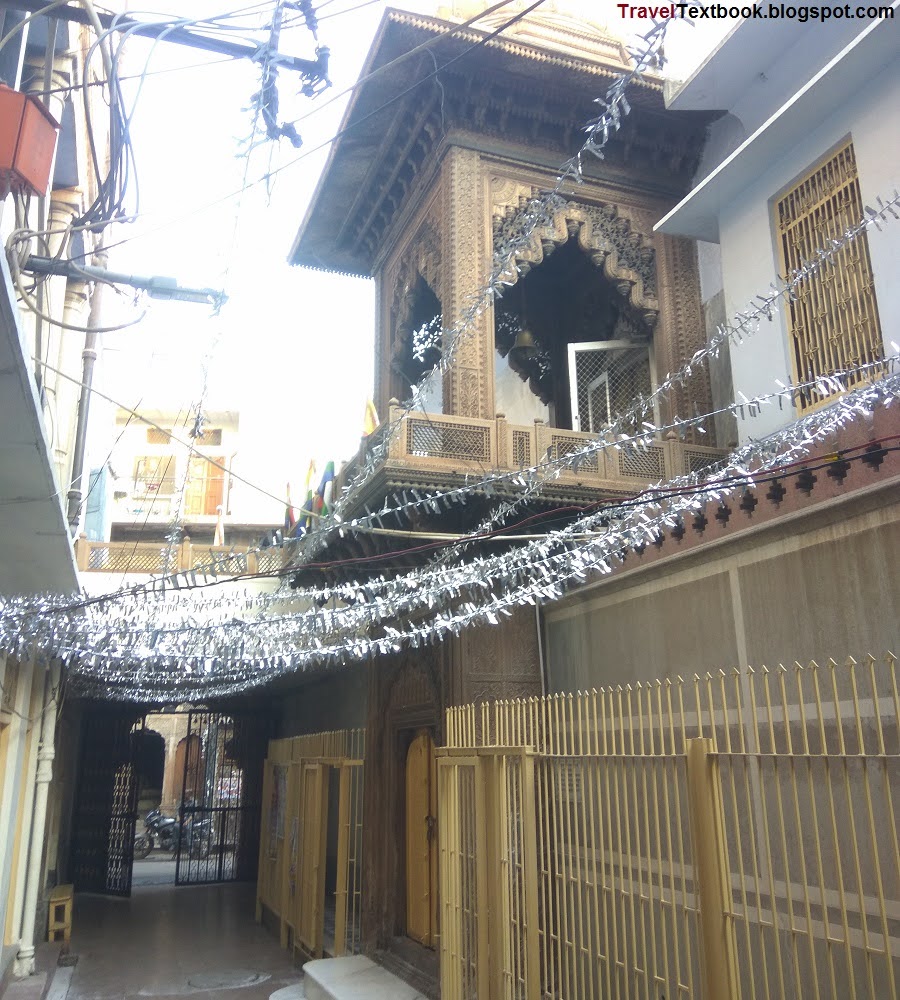
In 1800–1807, the royal treasurer Raja Harsukh Rai obtained royal permission to build a temple with a shikhara in the Agrawal (pronunciation: Agrabal) Jain neighborhood of Dharamapura. The temple thus finely carved is now known as "Naya Mandir" (New Temple).
How to go: It is located about 70 meters from Golden Haveli Dharampura towards south on the right side.
Aah.. I just finished my journey today. It's time for dinner. Now I will go to the road opposite Gate-1, Jame Masjid to have food, as I mentioned earlier. Jame Masjid metro station is the nearest from there. I will use this station to return home after dinner.
Hope this post will help you. Write your comment below and please share it with your friends.
You May Also Like
Travel Delhi: Day-1
Travel Delhi: Day-2
Travel Delhi: Day-3
Travel Delhi: Day-4
Travel Delhi: Day-5
Travel Delhi: Day-6
Travel Delhi: Day-7
Travel Delhi: Day-8
Travel Delhi: Day-9
Travel Delhi: Day-10 (You are here)
Travel Delhi: Day-11
Travel Delhi: Day-12
Travel Delhi: Day-13
Travel Delhi: Day-14
Travel Delhi: Day-15
Travel Delhi: Day-16
Travel Delhi: Miscellaneous
Click below to go


No comments:
Post a Comment